Text
Google TV (Android TV) vs webOS, Tizen and other Review
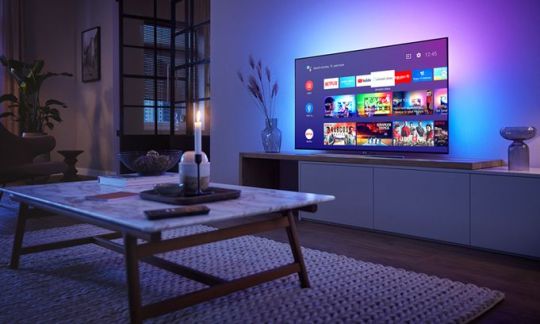
Of course, the list of TV selection criteria includes, first of all, its diagonal, price, image quality, HDR performance, etc. In turn, image quality is directly related to resolution, contrast (peak brightness and black levels), color gamut, etc. But all these factors are only important when there is content. In turn, its range directly depends on the Smart TV platform. Therefore, companies attach great importance to this aspect.
Many industry leaders use proprietary Smart TV platforms, including LG's webOS, Samsung's Tizen, Panasonic's MyHomeScreen, Hisense's Vidaa U and Vizio's SmartCast.
In addition, some manufacturers use Roku TV (Netflix's startup) and Amazon's Fire TV, which primarily target streamings from these giants.
Android TV has a special place on this list. Without a doubt, this platform dominates in terms of versatility and prospect. Of course, it has cons, including speed, not very user-friendly interface, the need for an app for iOS devices, etc. But they are secondary compared to its pros.
Pros
- perfect compatibility with Android devices;
- a huge number of apps on Google Play;
- third-party apps;
- support for apk (Android Package Kit) format;
- voice control;
- TimeShift.
As known, the TimeShift function saves the contents of the TV program during pause. Previously, this option required physical storage. TimeShift uses servers. Moreover, TimeShift supports rewinding.
An extraordinary situation has developed on the market today. Many prefer the excellent Samsung, LG, etc TVs, but they are not very happy with Tizen, webOS, etc. Unfortunately, replacing the pre-installed OS, for example, from Tizen to Android, requires external hardware via an HDMI cable or replacing the board in the TV.

Samsung QLED with Android TV
The photo shows the replacement of the board in Samsung QLED with an Android TV board with Amlogic S922XJ CPU.
Android TV & Google TV
As known, Android TV replaced Google TV in 2014. Last year, the Google Play Store re-launched the Google TV platform for smart TVs. In fact, Google has renamed Android TV back to Google TV, which can now be positioned as an updated Android TV.
The concept of Google TV is similar to the software shells that run on Android. But, for example, One UI is intended only for Samsung models, and Google TV is compatible with Android TV devices of any company.
Today Google TV is a software shell or interface for working with Android TV, supplementing this platform with new functions.
Google TV home screen - is the main interface change. As with most streaming services, it's recommendation based, and movies and TV shows are downloaded from the services you subscribe to.
The search uses an algorithm similar to the Google search engine. In addition, the platform offers a list to search for movies and TV series with a smartphone or tablet.
Probably, an intuitive interface can be positioned as the main direction of Google TV developers. The settings use the Google Home app.
Today new $ 50 Chromecast with Google TV already competes quite successfully with Roku and Amazon Fire TV. In fact, Google TV uses the Chromecast as a stand-alone streamer.

Chromecast with Google TV
Google TV offers over 6,500 apps and nearly all the main streaming services, including HBO Max, Apple TV Plus, Peacock, etc.
The default home page "For You" Section is very easy to use, providing instant navigation through the channels.

Google TV For You section
The speed is slightly inferior to the Amazon platform, but is sufficient for comfortable switching between apps.
This year Google TV will be used in Sony TVs and will receive Kids Profiles.
LG's webOS & Samsung's Tizen
LG introduced updated webOS 6.0 this year.
Pros
- easy setup & use;
- high speed;
- AirPlay for connecting Apple gadgets;
- connecting via Bluetooth;
- remote control with a gyroscope;
- many widgets;
- good universal search;
- Alexa and Google Assistant support;
- fast navigation.
Cons
- too few LG's apps;
- no Freeview Play (UK).
In 2014 webOS smart platform launched the trend for minimal user interfaces. This year, the company has already introduced the 6th generation, installing webOS 6.0 on all TVs 2021. Its new interface replaces the traditional full-screen app overlay.

LG webOS 6 interface
Updated home screen provides faster access to most used apps and may recommend content based on viewing history. WebOS perfectly supports Netflix streams in 4K with HDR and Dolby Vision, including Dolby Atmos audio. Amazon with UHD HDR and YouTube in 4K with Disney Plus are also available.
LG also plans to distribute the webOS platform to third-party televisions.
Tizen

Samsung Tizen
Pros
- easy setup & use;
- high speed;
- convenient two-level menu;
- recording of TV broadcasts;
- voice control;
- Apple TV support;
- AirPlay for connecting Apple gadgets;
- free channels on TV Plus;
- fast navigation.
Cons
- universal search sometimes crashes;
- too few apps in the Samsung's store.
Like webOS, the Tizen OS interface is focused on simplicity. It uses icons, apps and shortcuts across the screen bottom. "Recent" box in the left corner is intended for switching between apps and channels.
On-screen icons can be changed. Smart Hub multimedia page is handy for separating content from apps and from USB sticks.
New Mobile Multi View feature supports simultaneous viewing on TV and smartphone while casting.

Tizen Mobile Multi View feature
Roku TV
This smart TV platform is rightfully considered one of the most successful.

Roku TV
Pros
- very easy setup & use;
- high speed;
- a lot of apps;
- great universal search.
Cons
- too plain functionality;
- mostly used in budget models.
This platform was announced in 2014 for TCL TVs. Today, it used in TCL, Hisense, Haier, Insignia, and Sharp TVs.
Roku TV has universal search function to scan over 30 different apps, including Netflix, Google Play TV and Movies, Amazon, VUDU, etc. According to the search results, it offers the lowest price on the TV show or movie, and more 4,500 channels.
Today intuitive Roku TV is a best egalitarian second-division OS. Unlike Apple TV or Amazon Fire TV, it's not affiliated with a particular streaming platform and seeks content in a completely unbiased manner. As a result, Roku TV offers Pluto.tv, tubi, Crackle, etc as often as Netflix, Hulu, Sling TV and Amazon, expanding content selection.
Additionally, the platform offers several very useful features, including tracking of upcoming movies and TV shows through My Feed section, a free TV streaming service, and a private listening mode (headphones via remote).
Panasonic's MyHomeScreen
Pros
- high speed;
- updated 4K media player;
- easy setup & use;
- menu customization;
- good universal search.
Cons
- connection with a smartphone requires additional software;
- no Disney Plus.
Panasonic OLED TVs 2021 already use the new MyHomeScreen 6.0 with My Landscape option, which offers a collection of colorful images.
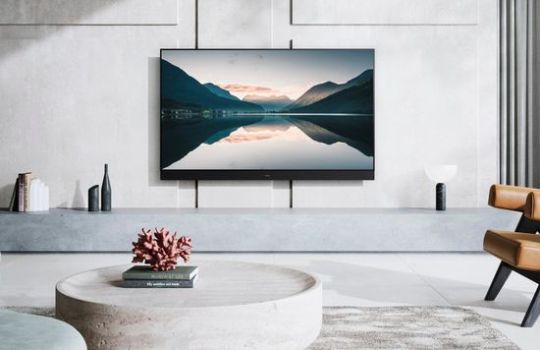
Panasonic My Landscape
Like LG's webOS 6.0, the remote contains several direct launch buttons.
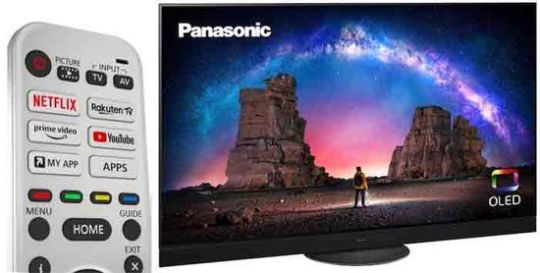
Panasonic My Home Screen
Dual Bluetooth supports transmission to two devices simultaneously. Cast Function allows you can easily cast Netflix shows from smartphone to Panasonic TV via Wi-Fi.

Panasonic Cast Function
Unfortunately, the new OS is only available on 2021 models.
Probably simplicity is one of the main pros of the platform. Pressing the Home button on the remote activates Live TV, Apps, and Devices.
Freeview Play opens up a full list of catch-up services, including BBC iPlayer, ITVhub, All4, My5, BBC News & Sport and UK Play. The iPlayer app supports 4K and HLG (Hybrid Log-Gamma), which is the broadcast version of HDR.
Amazon Fire TV
Pros
- easy setup & use;
- high speed;
- many apps;
- good universal search;
- Amazon Video.
Cons
- mainly Insignia and Toshiba budget TVs.
The Fire TV version update of the app has a new home screen and independent user profiles that can recommend different content to each family member.

Amazon Fire TV
The software was announced last September and debuted on the third-generation Fire TV Stick Lite and Fire TV Stick 4K in December. They now have the 1st and 2nd generation Amazon Fire TV Cube.
In fact, Amazon Fire TV became the proprietary OS that was used in the Amazon Fire TV streaming stick. Overall, Alexa is one of the best voice assistants, and Fire TV platform is fast and versatile. Today many people buy Amazon Fire TV Stick 4K and connect its to TV.
Conclusion
In general, the growth in the quality of smart TV platforms is blurring the differences between them. Almost all modern platforms are easy to set up and use, and work quickly and reliably. The Roku TV platform is great in its simplicity and efficiency, but the direction of its further development is not clear. At the same time, Google TV (Android TV) remains dominant in terms of versatility. Today it's used by Sony, Philips, Xiaomi, TCL, Hyundai, and other companies. Moreover, this list continues to expand. If this trend continues with the new Google TV, its outlook seems more preferable.
The Amazon Fire TV streaming stick is also very promising. Of course, comparing Google TV with streaming stick is hardly correct, but both of these directions successfully solve the same problem today. However, in any case, the consumer market will benefit from this competition.
This video offers a presentation on the new Google TV platform.
Read the full article
#AmazonFireTV#AmazonFireTVStick#AndroidTVplatform#GoogleTVplatform#HisenseVidaaU#LGwebOS6.0platform#MobileMultiViewfeature#PanasonicMyLandscape#PanasonicMyHomeScreen6.0platform#RokuTVplatform#SamsungTizen5.5platform#TimeShift#VizioSmartCast
0 notes
Text
Hisense TVs 2021 Review

As known, the Chinese state Hisense corporation was founded in 1969, and today it's one of the ten largest companies in China. The development and production of high-tech consumer electronics is one of the main areas of its activity. Today Hisense has 13 factories in China, production sites in Egypt, Mexico, Hungary, South Africa, Algeria, France, the Czech Republic, and 12 research centers around the world.
The company's products are known under several brands, including:
- Hisense (TVs, smartphones, washers, refrigerators, air conditioning systems);
- Toshiba (TVs - Hisense bought Toshiba Visual Solutions in 2017);
- Gorenje (kitchen appliances);
- Kelon (air conditioners);
- Ronshen (refrigerators).
Since 2015, the company has been selling Sharp-branded TVs in America.
Today many Hisense models are frequently featured in various top lists. For example, according to some experts, Hisense R8F ULED 4K UHD Roku TV wins in price-performance ratio even compared to the TCL R617 4K UHD from the legendary TCL Class 6-Series Roku TV.
The company is experimenting in different directions. For example, in 2018 Hisense launched its first OLED TV. This experiment ended in failure. In 2019, the company introduced a new OLED OB8 model in Europe, but its quality was significantly inferior to LG, Panasonic and Sony. As a result, at CES 2020, the company announced its intention to ditch OLED technology, focusing on developing its own LCD-based ULED technology.
Already in May of this year the company announced the new U9DG series with the fantastically promising Hisense Dual Cell or ULED XD technology.
Hisense TVs
Like the rest of the industry leaders, Hisense expands its TVs lineup every year. This year was no exception. In addition to the H4, H55, H65, A 60, R60, R8, H8, H9 series, the company has released the A6G, U6G, U7G, U8G and U9G series. Moreover, the U9DG with Dual Cell technology really claims to become a sensation this year and compete with the equally innovative mini LED backlit technology from TCL, Samsung and LG.
All TVs of new Hisense series have 4K UHD (3840 x 2160) resolution, full array LED backlit, Auto Low Latency Mode (ALLM) function (automatic switching to the mode with minimal input lag), Chromecast built-in (streaming content directly to TV), support HDR (High Dynamic Range) formats, Bluetooth Connectivity, Voice Remote & Google Assistant, and DTS Virtual: X surround sound.
Surround sound is provided by DTS Virtual: X. As known, DTS Virtual: X is a multi-channel audio format that was designed for 5.1 or 7.1 sound without additional ceiling speakers for home theater.
It's based on DTS: X and DTS Neural: X formats. In turn, DTS: X was first announced at CES 2015 by Digital Theater System (DTS) as an alternative to Dolby Atmos. In fact, this technology generates 3D effects in room.
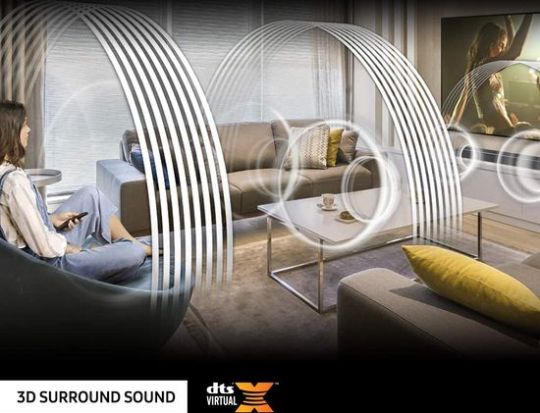
DTS Virtual X
Using built-in algorithms, it distributes power between the front and rear channels, forming acoustic waves at the desired point in viewing area.
The budget Hisense 4K UHD A6G is available in 65 "($ 550) & 50" ($ 360).

Hisense A6G
The A6G is the only non-ULED series without a Quantum Dot Color display. It provides 300 nits brightness, has 4x HDMI 2.0, Refresh Rate 60 Hz, supports Motion Rate120, Dolby Vision & HDR10. But unlike ULED series, the A6G does not use Quantum Dot Color and Local Dimming.
Hisense 4K ULED U6G
Hisense U6G is budget ULED series of this year. It contains 50, 55, 65 and 75-inch TVs with prices ranging from $ 480 to $ 1,050.

Hisense U6G
This very inexpensive series with excellent image quality without blotchiness or blooming may well take a place among the bestsellers in the budget segment. It offers up to 600 nits of brightness, has 4x HDMI 2.0, Refresh Rate 60Hz and supports Motion Rate 240. In addition, the series supports for Dolby Vision, HDR10+, HLG formats.
Like all ULED (Ultra LED) series, it supports Local Dimming for 60 zones and Quantum Dot Color (Quantum Dots technology with Wide Color Range).
This ingenious technology has dramatically expanded the color gamut and HDR performance by enhancing the white quality of LED backlit in LCD TVs.

Quantum Dots image quality
Technology uses an additional film with nanoparticles, the size of which corresponds to the wavelengths of red and green. The blue LEDs of backlit illuminates the film, the nanoparticles of which partially absorb blue, emitting green and red, depending on their size. At the output, red + blue + green generates high quality white, which is sent to an RGB matrix to form an color image.
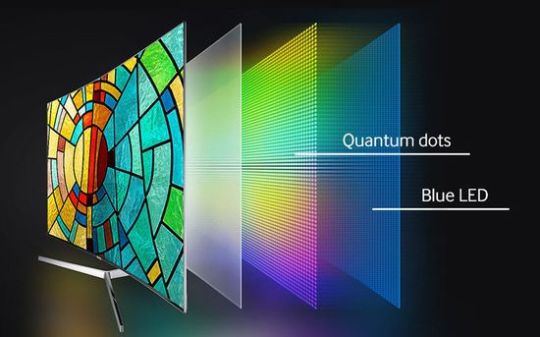
Quantum Dots technology
Today Quantum Dots technology is known as Samsung QLED, LG NanoCell, Hisense ULED and Sony Triluminos. Other companies use generic names such as "Quantum Dots display", etc.
As known, Local Dimming increases the panel contrast by adjusting the backlit intensity in separate fragments of the frame, depending on the content.

Local Dimming technology
In addition, it supports Dolby Vision HDR picture and Dolby Atmos sound.
U6G TVs support the popular FilmMaker Mode without post-processing. It provides the most realistic reproduction possible with original aspect ratios, colors and frame rates.
Hisense U7G & U8G
The U7G is a gaming series and includes 55, 65 and 75-inch TVs. But today only a 65-inch model is available for $ 950.

Hisense U7G ULED
Its peak brightness reaches 1000 nits. This series uses 72 local dimming zones. Unlike U6G, it has the 120Hz panel, HDMI 2.1, supports Motion Rate 480 and VRR (Variable Refresh Rate). For HDMI 2.1 with ALLM, it offers Game Mode Pro.
As known, VRR matches the refresh rate to the frame rate of game console. Unlike movies with a constant frame rate (usually 24 or 50/60 fps), in games it changes depending on the CPU load. For example, an inactive game fragment can be played at approximately 50 fps. But when the scene changes, the intensity can increase dramatically, lowering the frequency, for example, to 30 fps. These abrupt changes are often accompanied by display freezes. VRR addresses this issue by dynamically adjusting the refresh rate based on the game's frame rate.

VVR
Today AMD and Nvidia use their own FreeSync and G-Sync VRR formats. A lesser known HDMI VRR format is part of the HDMI 2.1 spec and is often found in new TVs, including models with only HDMI 2.0 connectors. But almost all TVs with HDMI 2.1 support HDMI VRR.
Additionally, built-in microphones duplicate Voice Control without a remote. In addition, the series supports IMAX Enhanced and DTS.
Overall, VVR, higher brightness, 120Hz panel, HDMI 2.1 are more than enough compensation for a few extra hundred dollars over the U7G.
Hisense Premium 4K ULED U8G includes 55 and 65-inch TVs priced at $ 950 & $ 1,300.

Hisense U8G ULED
Unlike the U7G, its peak brightness reaches a premium 1500 nits, and Local Dimming uses 132 zones. The other specs of these series are identical.
Hisense U9DG Dual Cell Android TV
Of course, the U9DG with the super innovative Dual Cell technology is the main intrigue. This series will only include a 75-inch model priced at $ 3,500.

As known, TCL, Samsung and LG improve the contrast of their LCD TVs by improving Local Dimming, which controls of the backlit intensity in the screen areas depending on the frame content. Today the companies have developed their own mini LED backlit technologies based on miniature LEDs. Their size allowed developers to place tens of thousands of LEDs on the panel and group them into thousands of Local Dimming zones with separate control. At CES 2021, the companies have introduced TCL OD-Zero (X12 8K OD-Zero Starlight Smart Screen), Samsung Neo QLED and LG QNED series based on this super-innovative technology. Hisense and Panasonic have taken a different path, drastically increasing the number of Local Dimming Zones with a second monochromatic black-and-white LCD layer.
Simply put, Dual Cell technology uses two LCD layers in one TV.
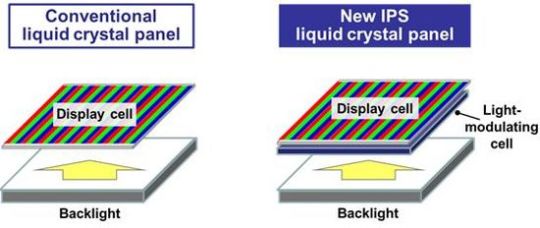
Hisense ULED XD
In fact, a monochromatic light-modulating cell ("luminance" module) displays content like a traditional black and white screen. In turn, this image can be positioned as an analogue of the backlit with Local Dimming for the RGB layer ("color" module). In this case, each pixel of the monochromatic layer acts as a primitive local dimming zone at the pixel level.

Hisense Dual Cell
The 1080p resolution of the monochromatic layer in the U9DG delivers over 2,000,000 pixels - zones! According to the company, its dynamic contrast ratio reaches 2,000,000: 1. Its black level is unprecedented 0.00003 nits. Combined with a claimed 1,000 nits peak brightness and Quantum Dot Color, this TV can deliver superb HDR performance.
Conclusion
This year turned out to be rich in technological breakthroughs. Their list includes:
- Samsung Neo QLED, LG QNED and TCL OD-Zero Mini-LED technologies;
- OLED Evo technology in LG G1 Gallery Series OLED TV with increased peak brightness up to 1,000 nits;
- Hisense Dual Cell technology.
The new technologies have practically erased boundaries between OLED & LCD TVs. As a result, specs and prices of new LG OLED C1 and G1 are quite comparable with new Samsung Neo QLED Mini LED TVs. Therefore, comparison of LG OLED vs Samsung Neo QLED is quite correct.
Moreover, prices for the new LG QNED MiniLED TVs (unknown today) may well exacerbate competition in the mid-budget segment.
Hisense Dual Cell U9DG with the popular Android TV, claimed dynamic contrast ratio of 2,000,000: 1, Quantum Dot Color and 1,000 nits peak brightness, heightens the intrigue in the premium segment. At $ 3,500 for the 75-inch model, it can compete successfully with the gorgeous $ 2,200 LG G1 Evo OLED for the 55-inch TV (other sizes not available yet) and the excellent Sony OLED Bravia XR A90J priced at $ 3,800 for the 65-inch model.
But regardless of the results of their competition, the ingeniously simple idea of Dual Cell technology evokes aesthetic admiration. In fact, the monochromatic light-modulating cell ("luminance" module) displays content like a black and white screen and works like a traditional Local Dimming backlit for the RGB layer ("color" module).

Dual Cell
It can actually have fantastic perspectives, allowing companies to implement Local Dimming at the pixel level.
This video introduces the innovative Dual Cell technology in the latest Hisense U9DG Android TV.
Read the full article
#AndroidTV#DualCelltechnology#HisenseA6G#HisenseTVs2021#HisenseU6GULED#HisenseU7GULED#HisenseU8GULED#HisenseU9DGAndroidTV#HisenseULEDXD#LGOLEDC1#LGOLEDG1#LGQNEDMiniLEDTVs#LocalDimming#QuantumDotColor#Quantumdotstechnology#SamsungNeoQLEDMiniLEDTVs#SonyOLEDBraviaXRA90J#TCLOD-Zero#VVR
0 notes
Text
Hisense Dual Cell technology vs mini LED backlit Review

As known, the picture quality depends significantly on contrast, which is the ratio of the panel's peak brightness to the minimum black. Contrast provides image clarity and sharpness, colors saturation, etc. As a consequence, companies focus their efforts in this direction.
Self-emitting LEDs in OLED and micro LED panels operate without backlit, formally delivering infinite contrast due to perfect blacks.
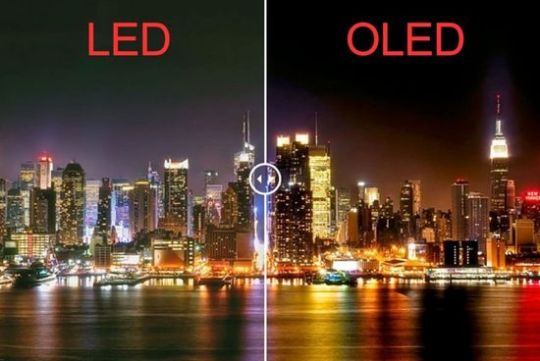
OLED vs LED LCD TV image quality
Indeed, the LED does not emit without a control signal, providing a completely black pixel. But OLED TVs are more expensive and less bright vs LCD. Even modern premium OLED models deliver up to 800 nits peak brightness. However, the brightness of some even mid-budget LCD panels reaches 1000 nits. On the other hand, LG this year unveiled LG G1 OLED series with the innovative Evo OLED panel, which peak brightness can exceed 1,000 nits. Micro LED panels offer impeccable quality, but they are insanely expensive, and their size starts at 100 inches on the diagonal. For example, the price of presented at CES 2021 110-inch Samsung Micro LED panel reaches $ 156,000.

Samsung Micro LED panel CES 2021
LCD TVs
Until recently, models based on OLED and Micro LED technologies belonged to the premium segment, with little overlap with the segment of significantly cheaper LCD TVs. But manufacturers of LCD TVs also did not waste time, actively improving the image quality through innovative technologies. As a result, the situation is changing today. Already this year new LG OLED TVs and Samsung Neo QLED TVs with mini LED backlit was in the same price segment.
Modern LCD TVs use Quantum Dot (QD) technology to increase peak brightness and expand color gamut, and Local Dimming to enhance contrast by increasing black depth.
Local Dimming enhances contrast by reducing backlit intensity in different frame areas depending on the content.
Until this year, FALD (Full Array Local Dimming) was the most effective technology. But at CES 2021, TCL, LG and Samsung unveiled a new generation of mini LED backlit that uses tens of thousands of miniature LEDs grouped into thousands of Local Dimming zones. In fact, the TV market has formed a new segment of LCD TVs with QD display and mini LED backlit, which today includes Samsung Neo QLED, LG QNED and TCL OD-Zero TVs.

mini LED backlit
Hisense and Panasonic have gone the other way, enhancing the contrast of LCD TVs with an optional monochromatic LC layer. These technologies are named Hisense Dual Cell (ULED XD) and Panasonic MegaCon.
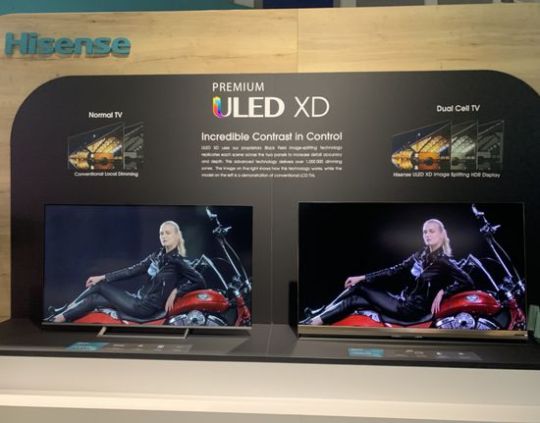
Hisense Dul Cell technology
Hisense Ultra LED (ULED)
Virtually all industry leaders use proprietary names for their QD models. This technology provides Wide Color Gamut, which directly affects picture quality and HDR performance. Simplistically, this a very elegant solution dramatically improved the white quality of the LED backlit and overall picture quality in LCD TVs.

Quantum Dots image quality
As known, only the sun provides ideal white. In fact, the developers of QD technology have created an analogue of a small sun by generating artificial white in TV. For this purpose, an additional film is placed between the blue diodes on the backlight panel and the subpixel color filter. It has randomly deposited two types of nanoparticles, the sizes of which correspond to the wavelengths of green and red. Nanoparticles absorb blue and emit red and green. At the output, they are blended with unabsorbed blue to produce a higher quality white that is sent to a subpixel color filter.
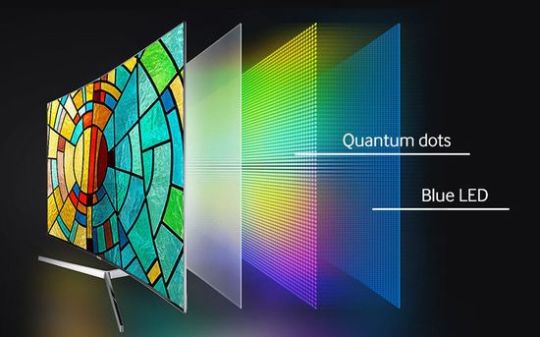
Quantum Dots technology
Today the market offers Samsung QLED, Sony Triluminos, LG NanoCell TVs with this technology. Other companies often just indicate "QD display". Most of them use QDEF (Quantum Dot Enhancement Film) from California-based Nanosys, which has confidently dominated this segment, developing quantum dot materials for displays since 2001.
Hisense is no exception and also uses the ULED (Ultra LED) name for its TVs with QD. In fact, ULED models include innovative solutions based on 20 different patents and can be divided into four main subgroups:
- Ultra Wide Color Gamut (QD display with Nanosys QDEF, 99.98% DCI-P3);
- Ultra Local Dimming;
- Ultra 4K Resolution (3840 x 2160 or 2160p);
- Ultra Smooth Motion Rate (frame interpolation algorithm).
Local dimming
As known, the LCD panel uses the dependence of the light transmission on crystal polarization. In turn, the polarization depends on the electric current, the supply of which is regulated through the transistor. But initially, the luminous flux is formed by the backlit. In fact, LEDs create light, which is partially absorbed by liquid crystal layer controlled by transistors, creating a color image.
Unfortunately, crystals only partially block the luminous flux from the backlit even for black LCD pixels. Some light always leaks through. As a result, LCDs have always had worse black levels and, accordingly, contrast compared to OLED.
In fact, Local Dimming is the main and only way to solve this problem. It's based on reducing the radiation intensity of individual groups of LEDs (Local Dimming zones). Of course, competition is forcing industry leaders to actively improve this technology. As a result, direct backlit has been improved to FALD (full-array local dimming), which in turn has been improved to mini LED backlit.

FALD (full-array local dimming)

Mini LED local dimming
The innovative mini LED backlit uses a huge number of miniature LEDs combined into thousands of individually controlled local dimming zones. Moreover, over several years, the Chinese giant TCL has developed and presented three generations of this technology.
The triumphant dominance of this technology in LCD TVs has become one of the trends of CES 2021. LG QNED, Samsung Neo QNED TVs and presented in March TCL X12 8K OD-Zero Starlight Smart Screen have actually formed a new segment of LCD QD TVs with Mini LED backlit. Moreover, LG OLED & Samsung Neo QLED TVs with roughly the same picture quality, compete in the same price segment, despite different display technologies (OLED vs LCD QLED).
Hisense Dual Cell or ULED XD technology
Instead of improving the Local Dimming with LED backlit, Hisense and Panasonic have come up with an ingenious alternative solution by adding an additional monochromatic LCD layer or light-modulating cell.

Hisense ULED XD
Its black areas block out excess light, dramatically increasing the black depth on the screen. In fact, Dual-layer LCD with Dual Cell technology uses a second monochromatic LC layer ("luminance" module) to predimming the light from backlit in the corresponding frame areas. Then, the modulated luminous flux is directed to RGB layer ("color" module).
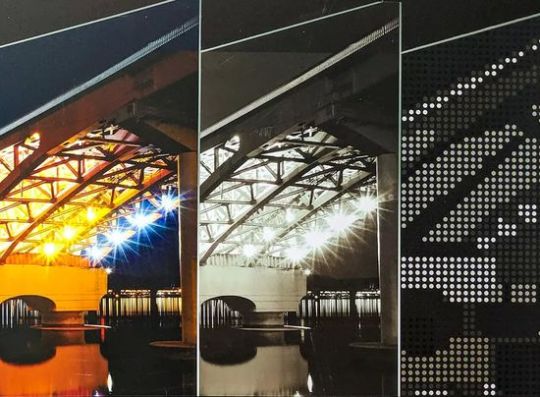
Hisense Dual Cell
The figure illustrates a dual-layer LCD operation principle, where local dimming backlit is displayed right, luminance-controlling LCD layer - in middle, and color-controlling LCD layer - left.
Technically, this technology only requires the addition of film, and should not drastically increase their price.

Panasonic Megacon
In fact, ULED XD precision-bonds two LCD modules together, one of which handles the luminance information (black and white only), second - colors.
In May company presented a prototype with a monochromatic luminance module of HD resolution in combination with a 4K color module (over 2 million pixels). But Hisense promises to increase the resolution of the luminance module to 4K (3,840 x 2,160). In fact, this technology can be positioned as local dimming on the pixel level with 8.3 million zones!
According to the company, ULED XD TVs will also use standard local dimming with 132 zones, which will provide an overall native contrast ratio of 1,000,000: 1! Hisense also lists the black level of ULED XD up to 0.00003 nits and a peak light output over 1,000 nits.
Additionally, QD technology provides 100% DCI P3 & 84% Rec 2020, and native refresh rate for both panels is 120Hz. As known, Hisense uses Android TV OS.
Conclusion
Preliminarily, 75-inches Hisense Dual Cell U9DG will be available already this summer for $ 3,500. Probably, many experts are eagerly awaiting the opportunity to compare Hisense Dual-Cell U9DG TV with the best OLED models (for example, Sony Bravia XR A90J or LG G1 Gallery Series) and with the best LCD TVs with QD & mini LED backlit (for example, LG QNED, TCL OD-Zero, or Samsung Neo QLED TVs.)
Given the declared 2,000,000 Local Dimming zones & peak brightness of 1,000, the image quality and HDR performance of the new Hisense Dual-Cell U9DG leaves no chance for other competitors.
But overwhelming advantage of any technology is unlikely. Maybe ophthalmologists can tell us the maximum perceived contrast. Probably, many people remember the smooth fading of the agitation around the resolution. According to many ophthalmologists, our vision ceases to perceive the difference between 4K and 8K resolution from a distance of a meter or more. Sophisticated research by South Korean scientists was only able to reveal "subconscious perception", when many subjects could not distinguish between 4K and 8K, but the coffee in the 8K image seemed to them "more hot". However, the comparison results will provide some answers:
- will OLED TVs retain the lead with the brighter innovative Evo OLED panel (LG G1) in picture quality?
- what will be the real increase in contrast, taking into account the price of mini LED backlit (Samsung Neo QLED, LG QNED and TCL OD-Zero) vs Dual-Cell technologies (Hisense and Panasonic).
But, of course, regardless of the comparison results, the consumer market will benefit.
This video offers a presentation on Hisense Dual Cell Technology.
Read the full article
#dual-layerLCDoperationprinciple#EvoOLEDpanel#FALD#full-arraylocaldimming#HisenseDualCelltechnology#HisenseU9DG#HisenseULED#HisenseULEDXDtechnology#LGG1GallerySeries#LGQNED#LocalDimming#MiniLEDbacklit#PanasonicMegaCon#SamsungNeoQLED#SonyBraviaXRA90J#TCLOD-Zero#TCLX128KOD-ZeroStarlightSmartScreen
0 notes
Text
Siemens EQ.500 Classic vs EQ.500 Integral series Review

The new Siemens EQ.500 Classic and Integral were introduced over a year ago.

Siemens EQ.500 Classic & Integral
In fact, this series became the third on the new platform, which uses a screw brewing unit (coffee up to 14 grams) and an original coffee grinder with a ceramic flat burr. Instead of the traditional second millstone, it uses a top steel pressure plate. According to the regulations, the coffee grinder changes entirely with the engine, without the possibility of replacing the millstones separately. From a maintainability point of view, such a decision seems controversial. In addition, the grinder only supports three grind levels. However, this is quite natural for this price segment.
Platform and controls
Other platform components:
- flow-through 1500W thermoblock;
- 15 bar pump;
- compartment for coffee beans for 270 grams;
- 1.7 liter water tank.
The color touch screen is located on the flat top panel.
But such ergonomics can be inconvenient for short people. Considering the traditional height of the kitchen worktop (85-90 cm) and the coffee machine height (just under 40 cm), the panel is actually located at a height of almost 130 cm. As a rule, the coffee machine is placed in the back of the worktop, closer to the wall. For controls, developers usually use a front or beveled panel. In this series, some controls, including the screen, buttons for settings, navigation and entry into the menu are located on a flat horizontal panel at a height of about 130 cm. This can be inconvenient for short people, teenagers, etc.
But large touch buttons for direct beverage start are conveniently located on the front beveled bezel.

Siemens EQ 500 Control
They provide:
- Espresso - 30 - 50 ml;
- Coffee (lungo) - 80 - 240 ml (DoubleShot from two grinds, except for espresso);
- Cappuccino - 120 - 220 ml, DoubleShot is available;
- Latte macchiato - 200 - 360 ml, DoubleShot is available.
The right button activates menu with additional recipes, the list of which depends on the model. Unfortunately, it does not open the list of drinks in the menu, but goes through the recipes one after another with a long press. Accordingly, the choice of the fifth drink will require pressing this button five times, which is hardly convenient.
New screw brewing unit
The new screw-type brewing unit was first used in the EQ.9.

Siemens EQ.300 brewing unit
Today statistics with its usability and reliability are already available.
Unfortunately, this precision mechanism from plastic is very sensitive to clearances and movement of moving parts. As a result, at first, the mechanisms of some models sometimes jam, requiring you to manually bring the piston to the stop. However, after a few operation cycles, this problem often disappears. Perhaps its moving parts have to get used to each other. But in general, this component requires periodic lubrication at least once every 200 cycles.
Moreover, plastic wears off faster in places of maximum mechanical stress due to contamination. As a result, the entire unit requires replacement over time. But regular and thorough rinsing under running water solves this problem.

Siemens EQ.300 Care
In addition, some EQ.500 buyers faced another problem. When they turn on the coffee machine for the first time, it generates an error and asks to insert the brewing unit. This problem may be caused by improper transportation. For example, the absence or unreliability of transport stopper can cause the piston to move out of park.
A simple check before the first start-up will minimize this risk. It's enough to check the piston location, which is located on the bottom right of the block. It should be in the extreme right position. The user must push down on the red part of unit, and on the piston "to the right and inward" until it clicks.

Siemens EQ.300 Brewing unit fix
Perhaps this situation was caused by the carelessness of the company's counterparties in a separate region and today this problem has already been eliminated.
With careful maintenance, the new brewing unit functions perfectly.
Siemens EQ.500 Classic
Siemens EQ.500 Classic TP501R09 is the base model of the line and is available in several colors.

Siemens EQ.500 Classic TP501R09
The design of the cappuccino maker is main difference of model. The outlet tube comes out of a dispenser and can be used with any milk container.

Siemens EQ 500 Classic Cappuccino maker
Of course, this is very convenient.
But this design cannot simultaneously prepare two milk-coffee drinks. In addition to one-touch drinks, the TP501R09 only offers milk froth and hot water in the additional menu. In fact, this model makes only 4 basic drinks with one of the preset volumes. Unfortunately, programming the volume or proportions of coffee and milk are not available. However, this is normal for this price segment.
After the end of the working cycle, Siemens's AutoMilk Clean system automatically cleans it with steam.

Siemens AutoMilk Clean
Unfortunately, not all models in this series have a cup warmer.

Siemens EQ.500 Classic cup warmer
Siemens EQ.500 Integral
The cappuccino maker and recipe set are main differences from the Classic series. Like the flagship EQ.9 series, the cappuccino maker is a separate jug.

Siemens EQ 500 Integral Cappuccino maker
But it increases the device width from 25 to 32 cm. Of course, this factor limits it location in the small kitchen.
The long tube in the jug for sucking milk from the bottom can be used for any container, which is very convenient, for example, for a tetra-pack.
Moreover, the Integral series supports the simultaneous preparation of two milk and coffee drinks.

Siemens EQ.500 One Touch Double Cup
The list of additional recipes includes:
- classic Americano - espresso + hot water in a ratio of 1/2, with an adjustable volume of 80 - 200 ml;
- Flat White (classic cappuccino) - espresso + frothed milk, 120 - 220 ml;
- Espresso macchiato (milk + espresso), 50 - 70 ml.
The color depends on the model number:
- Siemens TQ505R09 - black;
- TQ507R02 - white with metal elements;
- TQ507R03 - black with metal elements;
- flagship TQ507RX3 - black with metal elements.
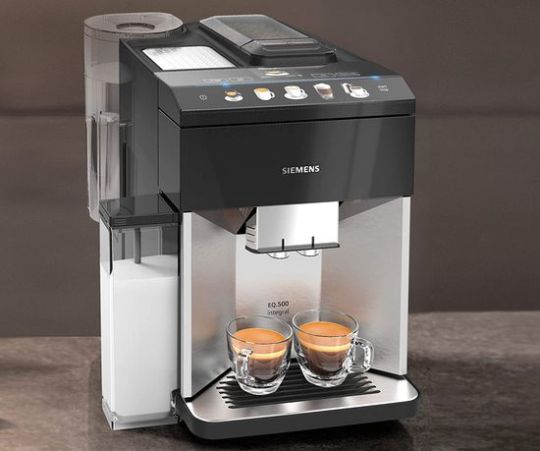
Siemens EQ 500 Integral
They have an active cup warmer at the top and a backlight.
Home Connect app
Flagship has Wi-Fi module for remote control via the Home Connect app.

Siemens Home Connect remote control coffee
This feature requires phones with Android 6.0 and above or iOS 12.0 and above. The Home Connect app supports launching additional recipes from within the app, including the unconventional Red eye, Melange (espresso with warmed frothed milk and whipped cream), Portuguese Garoto ("little boy" - a weak, watery espresso), etc.
As known, Red eye (black eye, death eye) is a popular strong American coffee drink. Its preparation involves adding espresso to coffee that is prepared using a filter.
In similar Canadiano, coffee from the filter is added to the espresso. In Alaska, Red eye is known as the "Sludge cup", and in the Northwest of the United States it's known as "shot in the dark."
The machine also provides single or double espresso, hot water and frothed milk. Unfortunately, only flagship supports programming the volume of coffee and milk for drinks.
Conclusions
Pros:
- very handy jug-cappuccino maker;
- high quality coffee;
- Home Connect app with a huge number of interesting recipes (for Integral TQ507RX3);
- AutoMilk Clean system (automatically cleaning the milk system);
- intuitive coffeeSelect Display;
- One Touch Double Cup;
- ceramDrive coffee grinder;
- iAroma System;
- SensoFlow System (precise temperature control in the range 90°С - 95°С);
- aromaDouble Shot - 5 coffee intensities.
Cons:
- the new precision screw brewing unit is sensitive to mechanical stress and requires very careful maintenance, including periodic lubrication;
- not all models have a cup warmer;
- only 1.7liter water tank;
- controls on a flat horizontal top may not be very convenient for short people;
- only flagship supports custom setting for the proportions of milk and coffee;
- the choice of additional drinks works on the principle of a carousel, requiring a sequential enumeration of all recipes.
Today Siemens EQ.500 and Siemens EQ.300 series offer models throughout segment of mid-budget coffee machines. They have a very good value for money. Only rather stringent maintenance requirements for the brewing unit can be positioned as a real disadvantage. However, it's relevant for all Siemens coffee machines based this platform. On the other hand, any modern complex consumer technology requires careful maintenance.
This video introduces the Siemens EQ.500 series of coffee machines.
Read the full article
#SiemensaromaDoubleShot#SiemensAutoMilkCleansystem#SiemensceramDrivecoffeegrinder#SiemenscoffeeSelectDisplay#SiemensEQ.300#SiemensEQ.500Classiccoffeemachine#SiemensEQ.500ClassicTP501R09#SiemensEQ.500Integralcoffeemachine#SiemensflagshipTQ507RX3#SiemensiAromaSystem#SiemensOneTouchDoubleCup#SiemensSensoFlowSystem#SiemensTQ505R09#SiemensTQ507R02#SiemensTQ507R03
0 notes
Text
Living room projector vs TV Review

For several years now, the market has shown a steady increase in the popularity of laser UST (Ultra Short Throw) projectors, which are placed in the living room instead of a traditional TV. Of course, projectors have been actively used before, but mainly for Home Theater. This was due to several objective factors, including the projector brightness, their placement, image quality, available content range, etc.
Large screen TVs
Of course, screen size remains the main advantage of a projector. But technology does not stand still, and today companies offer mondo-sized screen TVs in abundance. Unfortunately, they remain very expensive. For example, Sony TV's 85-inch LED LCD Ultra HD 4K has a price tag of nearly $ 3,000. Claimed price for the super innovative 85-inch flagship 2021 TCL X12 8K OD-Zero Starlight Smart Screen with OD-Zero backlit exceeds $ 15,000.

TCL X12 8K OD-Zero Starlight Smart Screen
And the price of the gorgeous 110-inch Samsung Micro LED panel will exceed $ 150,000.

Samsung 110-in Micro LED panel CES 2021
For most consumers, this miracle of technology remains only an object of admiration.
The situation is similar in the segment of OLED TVs, the price of which rises sharply as the screen size increases. For example, the price of the new 83-inch LG OLED C1 TV reaches almost $ 6,000.
In comparison, the beautiful new living room Epson EpiqVision LS300 UST 4K HDR smart projector costs only $ 2,000 in the base version, and $ 3,000 with a high-performance 100-inch UST ALR screen.
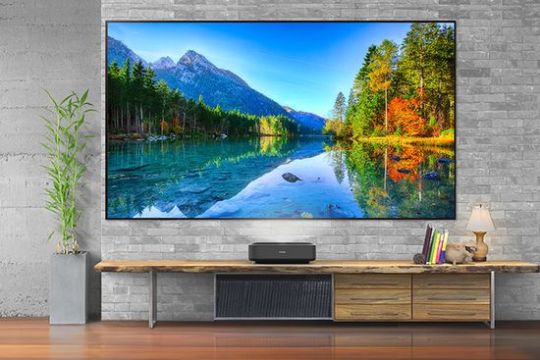
Epson LS300 UST projector
Traditionally, image quality is one of the main criteria for selection. It depends on brightness, resolution, contrast, color gamut, color accuracy, HDR performance, etc. But of course, the bandwidth (HDMI), input lag, refresh rate, smart functionality, etc also directly affect the consumer qualities of the model. The developers of TVs and projectors successfully solve all these aspects, and the statement about someone's domination is not very correct. For example, the picture quality of a premium projector is significantly higher compared to a TV in the budget segment.
Brightness
The projector image quality dependents on the ambient light. Even diffused daylight makes it dimmer and paler. Of course, window blinds and blackout curtains can solve this problem. But this fuss is unlikely to add comfort.
Increasing the projector light output (brightness) is a simpler and more convenient solution. But it has nuances.
Even not very expensive lamp projectors provide a brightness of several thousand Lm, but their lamp gets very hot during operation. As a result, these models are bulky (a large internal volume is required for heat dissipation), have a high noise level (the noise of powerful fans sometimes exceeds 40-50 dB) and a relatively short lamp life (up to 6,000 hours).
Compact, low-cost LED projectors offer virtually no heating, a lifespan exceeding 25,000 hours, but their brightness is too low to compensate for ambient light.
Powerful laser projectors provide high brightness up to several thousand Lm, do not heat up, have a lifespan of 25,000 hours or more, but they are significantly more expensive.

Sony VPL laser projector
Several years ago, these factors severely limited the prospects for laser projectors as an alternative to living room TVs. But huge progress in the segment of solid state light engine segment has radically changed situation. Today many industry leaders already offer powerful enough laser models starting at $ 1,000.
Several factors further mitigate the brightness problem. As known, 1-chip DLP projectors with a color wheel lose some of the light output in each cycle, passing only one color. But Epson's 3LCD technology works losslessly, always providing the same White Brightness & Color Brightness (CLO - Colour Light Output), reducing brightness requirements.

3LCD vs 1DLP brightness
Moreover, today companies offer affordable ALR (Ambient Light Rejecting) screens, which additionally reduce the loss of reflected light.
UST projectors
As known, traditional mid-focus projectors are installed in front of the screen at a distance of several meters. Usually, the wires on the floor are not an issue in the home theater room because of minimal activity in this room. In addition, most modern models have a ceiling mount. But this aspect is more important in the living room, where children and pets often play.
Of course, UST models have drastically reduced this problem by providing the projector placement almost close to the screen.

UST projector throw distance
Unfortunately, they require very precise alignment during installation.
In addition, the high-power laser beam can be hazardous to the eyes. Of course, an adult is unlikely to think of looking into the laser projector lens during operation. But the laser beam can be dangerous for curious children and pets. Therefore, many modern models have a protection that automatically turns off the laser with the help of motion sensor.
Unfortunately, traditional inexpensive ALR (Ambient Light Rejecting) screens are not very effective for UST models due to the acute angle of light incidence on the screen. In this case, a significant part of the light flux is reflected upward instead of the viewing area (the angle of incidence is equal to the angle of reflection). Companies have solved this problem by developing special UST ALR screens with this factor in mind.
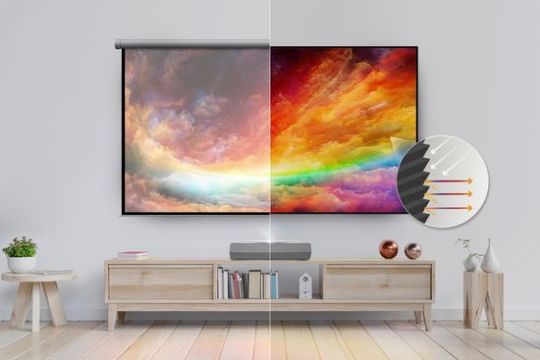
UST ALR Screens
But UST ALR (Ambient Light Rejecting) screens are very expensive today. For example, the price of a 100-inch UST screen reaches $ 1,000.
Color gamut, resolution & contrast
The color gamut and color accuracy of the compared devices are approximately the same and depend on the technology used. For example, comparing TVs with Quantum Dot technology (Samsung QLED, Sony Triluminos, LG NanoCell , Hisense ULED, etc.) with mid-budget projectors does not show clear advantages.
But the resolution of TVs is significantly higher. For example, even many modern budget TVs are 4K. The projectors with native 4K resolution continue to be positioned as premium projectors. But projector manufacturers are actively working in this direction. For example, Epson and Sony are actively improving the promising 4K e-shift technology.

4K E-shift technology
On the other hand, pixelation is perceived by the eye only at a relatively close distance from the screen, and the projector is designed for a large screen. Of course, viewing a 100-inch image is comfortable from a distance of at least a few meters. But the visual acuity of the majority is unlikely to be sufficient for perception of pixelation at that distance. Therefore, lower resolution is not very critical for projectors.
Of course, contrast has a significant impact on image clarity and color saturation, and modern TVs significantly benefit in this comparison. As known, OLED TVs and Micro LED panels with self-emitting LEDs provide almost ideal contrast. What's more, the innovative mini LED backlit promises dramatic contrast improvement even in LCD models with this technology. What's more, many modern TVs use the new Dolby Vision IQ technology, which optimizes contrast and brightness based on dynamic metadata and ambient light sensor information.
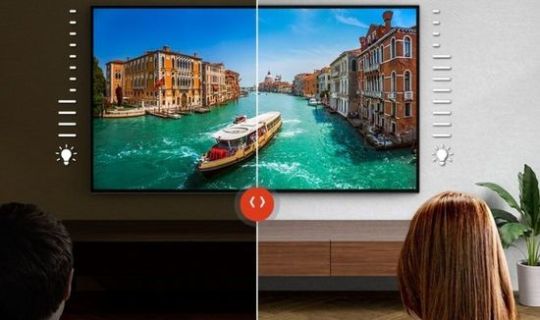
TV Dolby Vision IQ
In comparison, laser projectors provide approximately the same contrast ratio as LCD TVs with IPS panel and without local dimming technology. However, the contrast difference is visually reduced in a dark room.
HDR performance & screen mirroring technology
The importance of HDR performance increases with the growing popularity of this technology. As known, HDR mode significantly expands the color gamut, improving image quality.
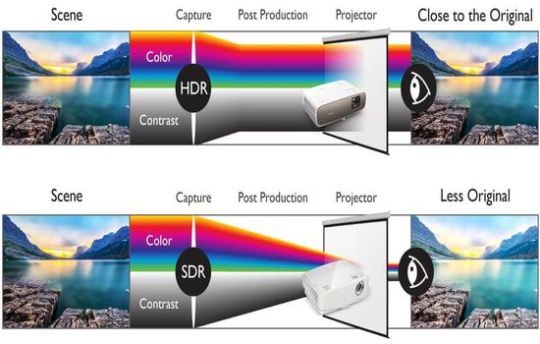
Projector HDR & wide color gamut
Sure, the brighter TVs usually outperform in this comparison, but this aspect has nuance.
In addition to HDR content, a full HDR mode requires a fairly bright 10 bit panel (or 8 bit + FRC) with Wide Color Gamut support, which are available only in expensive TVs. Budget and some mid-budget TVs do not meet these requirements, and, in fact, can only reproduce HDR content in SDR quality or slightly higher. This situation is similar to "4K compatible" projectors, which can accept 4K content. Then the device lowers the 4K resolution to native resolution and plays it. Of course, many are justifiably disappointed after purchasing of such TV with HDR support.
In fact, only fairly expensive TVs provide full HDR. But premium projectors also do an excellent job with this task.

Projector HDR color performance
Traditionally, TVs have had a huge advantage in terms of range and convenience of content. But the rapid development of screen mirroring technologies and smart functionality have virtually eliminated this difference. Almost all modern projectors support Chromecast, Miracast, broadcast via smartphone and WiFi, etc.

Chromecast, Miracast & Anycast
Conclusion
Probably, today TVs are preferable in terms of picture quality. Fierce competition ensures a constant increase in image quality and a huge range of them at relatively affordable prices. For example, this year the market offers:
- the latest Samsung Neo QLED and LG QNED with innovatve mini LED backlit;
- great LG OLED G1 and LG OLED C1;
- a huge range of TCL TVs;
- great Sony Bravia XR A90J, etc.
In turn, manufacturers of UST laser projectors for the living room are also not far behind, offering:
- Epson EpiqVision laser projectors, including LS500, new LS300, and mini EF12 at prices from $ 1,000 to $ 4,000;
- Optoma CinemaX 4K living room laser DLP projector - $ 3,300;
- VAVA VA-LT002 4K UST laser living room projector - $ 2,800, etc.
In general, the modern laser UST projectors are marginally inferior in image quality to similarly priced TVs, but radically gain in screen size. In addition, the difference in picture quality is reduced in low ambient light conditions. Moreover, the dedicated UST ALR (Ambient Light Rejecting) screen significantly improves the projector image quality.
Overall, UST projectors for living room today may well be positioned as the most cost-effective version of a very large screen. But, of course, the choice primarily depends on individual preferences.
This video reviews the Samsung Premiere LSP9T laser projector as a replacement for your everyday living room TV.
Read the full article
#4Ke-shifttechnology#DolbyVisionIQtechnology#EpsonEpiqVisionEF12#EpsonEpiqVisionlaserprojectors#EpsonEpiqVisionLS300#EpsonEpiqVisionLS500#LGOLEDC1TV#LGOLEDG1TV#LGQNEDTVs#livingroomprojector#MiniLEDbacklit#OptomaCinemaX4KlaserDLPprojector#SamsungNeoQLEDTVs#SamsungPremiereLSP9Tlaserprojector#SonyBraviaXRA90JTV#TCLX128KOD-ZeroStarlightSmartScreen#USTALRscreen#VAVAVA-LT0024KUSTlaserprojector
0 notes
Text
LG OLED vs Samsung Neo QLED TVs 2021 Review
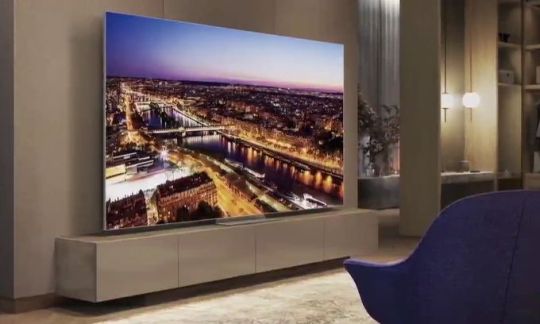
The heated debate about pros & cons LCD vs OLED technology has been going on for many years. However, they were quite academic in nature, since LCD & OLED TVs were in different price segments. But LG's efforts to reduce the OLED panel price and the progress of LCD TVs manufacturers to improve picture quality (QLED + Local Dimming with Mini LED backlit) are dramatically changing the situation.
OLED vs LCD 2021
This year, models based on these technologies are for the first time in the same price segment, sharply exacerbating the discussion. This year, models based on these technologies have mixed in the same price segment, which sharply exacerbates the discussion. In the segment from $ 2,000 to $ 3,000, the market today offers five quite comparable in price and quality TVs from the industry leaders. This list includes:
- LG OLED 65CX (2020) - $ 2,000;
- Samsung Neo QLED 65QN85A (2021) - $ 2,200;
- LG OLED 65C1 - $ 2,500;
- Samsung Neo QLED 65QN90A - $ 2,600;
- LG OLED 65G1 - $ 3,000.
Differences within the lines:
- unlike the new C1 & G1 with webOS 6.0, last year's LG CX has webOS 5.0 version, does not have new Magic Remote, and uses the α9 Gen 3 AI Processor 4K, which is inferior to the more performance α9 Gen 4;
- LG 65G1 - the first and only model today with an innovative OLED Evo panel, the brightness of which is increased to 1,000 nit.
New Evo OLED panels use an additional third green emitter layer.
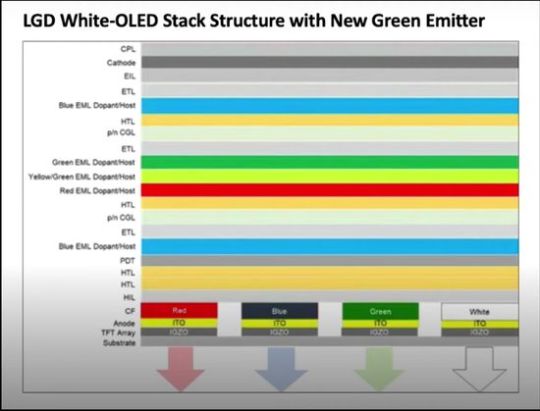
Evo OLED panel
Combined with red and yellow-green, this structure extends panel color gamut. Moreover, DuPont makes blue emitters from the more productive deuterium instead of hydrogen. Its improved performance allowed designers to increase panel brightness at the same amperage and, accordingly, without reducing panel life due to overheating;
- flagship Samsung 65QN90A uses a brighter VA panel with very high contrast ratio, QN85A uses ADS (Advanced Super Dimension Switch) panel with wider viewing angles, which is an improved IPS matrix.
A short introduction with main key features of modern TVs will help you more objectively assess the prospects for this year's potential bestsellers.
OLED & Micro LED panels
About five years ago, the evolution of TVs split into two directions.
LG and Sony have focused on developing innovative OLED technology that uses self-emissive pixels and therefore does not require backlit. This eliminated the problem of imperfect blacks due to partial transmission of light through the matrix in transmissive LCD panels. The fantastic contrast has become the main advantage of this technology.
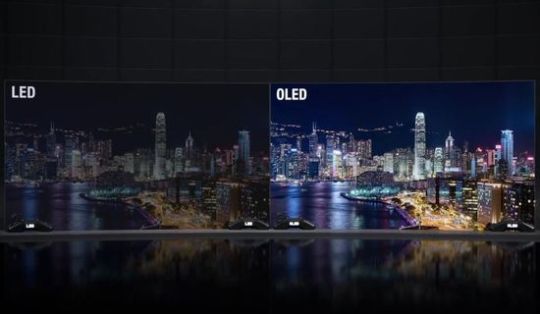
OLED vs LCD contrast
But it provides relatively low brightness, which has become one of the main cons of OLED panels. Of course, its key features also include wide viewing angles, reduced panel thickness, limited range of panel sizes, disproportionate price increases for large panels, limited blue pixel life due to burn-in, etc. But the importance of these aspects is constantly decreasing. On the one hand, manufacturers of OLED panels successfully expand the range of sizes, lower prices and extending their lifespan. On the other hand, LCD panel manufacturers have also been successful in increasing viewing angles and reducing panel thickness.
In fact, only excellent contrast at low brightness remain the main differences between the technologies. As known, the contrast directly affects the image quality, and peak brightness - HDR performance. In addition, the brightness is necessary to compensate for ambient lighting, for example, daylight.
Samsung is also pedantically develops Micro LED technology based on self-emitting diodes without backlit. But the company chose a different path. Samsung develops Micro LED modules, which are then assembled into huge panels using magnets. At CES 2019, Samsung even showed 13-inch modules for such panels.

Samsung Micro LED modul
This technology delivers amazing quality, but at an incredible price. For example, the 109-inch Samsung Micro LED panel at CES 2021 is worth more than $ 150,000.

Samsung Micro LED panel CES 2021
Quantum Dot technology & Local Dimming with Mini LED backlit
Of course, the LCD TVs developers weren't wasting their time either. Having developed a huge number of innovative technologies, the companies have brought LCD TV image quality very close to the level of OLED technology. Of course, QD technology and Local Dimming with Mini LED backlit dominate this list.
The elegant solution of the South Korean developers gives aesthetic pleasure. As known, only sunlight provides perfect white, but conventional LEDs cannot. After a little thought, the developers decided to create an analogue of a small sun in a TV, synthesizing it from blue, green and red.
This technology works as follows. Blue from blue LEDs passes through a matrix with nanoparticles, the size of which corresponds to the wavelengths of red and green. Then, the partially passed through the film blue is combined with re-reflected green and red, and they form a high-quality white, which is used to form the pixel colors.

Quantum Dots technology
This technology has dramatically improved the picture quality of LCD TVs.
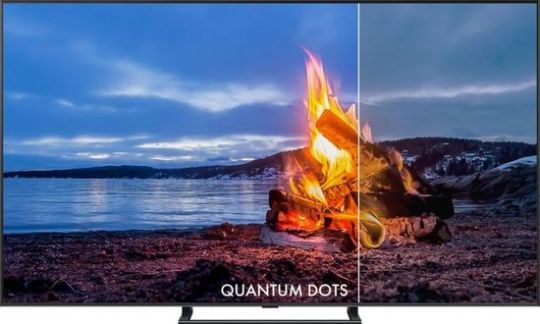
Quantum Dots image quality
Companies today have developed and are using several versions of this technology, including Samsung QLED, Sony Triluminos, LG NanoCell, Hisense ULED, etc.
The Mini LED backlit has significantly increased contrast by dramatically improving local dimming performance. By grouping a huge number of miniature LEDs into arrays, the developers have dramatically increased the number of independently controlled Local Dimming zones. For example, in March TCL announced a fantastic 85-inches TCL X12 8K Mini LED Starlight with 96,000 LEDs. In comparison, the legendary TCL 6-Series Roku TV (2018) used only 86 local dimming zones.
As a result, the difference in price and image quality between OLED and LCD with QD technology and Mini LED backlit has practically disappeared.
LG OLED G1 TV

LG OLED G1
Today LG OLED G1 TV is positioned as one of the best OLED 4K TVs. The innovative bright Evo panel harmoniously complements traditionally stunning contrast of this OLED TV. The excellent webOS 6.0 with new interface, expanded Magic Explorer, enhanced LG ThinQ AI and Next Pick function is an added bonus. Finally, 4 HDMI 2.1 inputs, amazing upscaling with new α9 Gen 4 AI processor 4K, and great gaming with 4K@120Hz support, Game Optimizer, G-SYNC, FreeSync, VRR and ALLM complement its pros. Perhaps only glare due to the reflective glass surface in daylight and the absence of HDR10+ can be positioned as a small cons.
On the other hand, $ 3,000 will partly offset its pros compared to other members.
Samsung Neo QLED QN90A

Samsung Neo QLED QN90A
Of course, Mini LED backlit is a main feature of the new series. Tens of thousands of miniature LEDs, united in thousands of local dimming zones controlled by Samsung Quantum Matrix system, radically increase the overall image contrast by precisely adjusting the brightness in each frame fragment.

Samsung Quantum Matrix technology
Moreover, the QN90A with VA panel is very bright. In particular, Dynamic Picture Mode in SDR with Standard Color Tone provides almost 1,790 nits (cd / m²) in the 10% window. But, of course, these settings slightly reduce image accuracy. The unprecedented brightness for HDR content reaches 1,600 nits, and even 1,800 nits for small bright peaks.
Native contrast ratio is 3500: 1, but locall dimming increases it to around 26000: 1.
The anti-glare screen perfectly suppresses reflections. The OTS+ system and 4.2.2 configuration provide a surround sound. As known, this sistem generates sound from the entire screen surface, synchronizing it with the source in the frame.
The very high brightness, excellent black levels and QD technology provide very accurate color reproduction with rich colors in all brightness ranges. High native contrast ratio, exellent Mini LED FALD and wide viewing angles complement its pros. Finally, good Pre Calibration out of the box, Tizen OS with MultiView (up to 4 sources), USB camera, Smart Things, Samsung DeX and Game Bar round out the shortlist of its pros. Of course, the TV supports 4K@120Hz. But unfortunately for gamers, the model does not support the G-SYNC.
LG OLED C1
In fact, the LG OLED C1 is almost identical to the G1, but without the innovative bright Evo panel and the new built-in Next-Gen (ATSC 3.0) tuner. It also has four HDMI 2.1 ports, gorgeous new webOS 6.0, supports Dolby Vision IQ to automatically adjust brightness based on ambient lighting sensor, and all modern gaming features, inciuding HDR 4K@120Hz, VVR in Nvidia G-Sync & AMD FreeSync Premium, etc. Input lag in Standard and Boost modes does not exceed 9.4 ms. But its brightness is inferior to the G1. At its brightest Vivid mode, it shows no more than 900 nits for HDR in a 10% white window. But in general, the model provides traditionally excellent image quality and gaming performance.
Like all LG TVs, it doesn't support HDR10+. As known, the company fundamentally prefers to use the Dynamic Tone Mapping mode, which actually converts HDR (High Dynamic Range) to LDR (Low Dynamic Range) to match content with model capabilities. Of course, this transformation is accompanied by losses, but it mimics our vision very effectively.
Simplified, these algorithms divide all image brightness values into three levels (dark, medium, and bright), estimate the brightness of the midtones, correct the overall brightness, and redistribute the their values between pixels in the scene (dark pixels are brightened, light pixels are darkened). Then, the algorithms reduce the brightest pixels to the panel's specs. Image demonstrates their performance.

Dynamic Tone Mapping operation principle
Dynamic Tone Mapping is used for the central fragment, along the edges - conventional HDR-LDR conversion.
Overall, this feature is quite effective.

LG TV Dynamic Tone Mapping
LG OLED CX
The C1 is positioned as an improved version of CX. But the differences between them are minimal. They are almost identical in design.

LG C1 vs CX design
CX uses the last year's Magic Remote, α9 Gen 3 AI instead of the new α9 Gen 4 AI Processor 4K, and webOS 5.0 instead of the new webOS 6.0 in LG TVs 2021.
Peak brightness for HDR format reaches 740 nits, the gamut coverage is 96% for DCI-P3, and 71% of Rec. 2020. Traditionally, TV provides amazing contrast and very accurate colors.
The internet offers a huge number of reviews for this model, which are backed up by over 4,000 rave reviews on Amazon over several months of sales. Many experts rightly position the LG CX as the best OLED TV 2020 in terms of value for money. With a high probability, it claims to retain its place among this year's bestsellers also.
Samsung Neo QLED QN85A

Samsung QN85A
Samsung QN85A is the second model in the new flagship Samsung Neo QLED line with innovative Mini LED backlit.
In SDR, the TV's peak brightness reaches 1,125 nits in a 10% white window, which is more than enough to suppress glare in almost any ambient light.
In HDR mode the maximum brightness reaches 1,250 nits with the maximum brightness and contrast settings in the "Movie HDR" mode (local dimming - "High", Color Tone - "Warm-2").
Moreover, “High” in Contrast Enhancer and max in ST.2084 even more boosts HDR brightness.
The QN85A uses an ADS (Advanced Super Dimension Switch) panel with wide viewing angles. Unfortunately, its native contrast is 1370: 1, or 2000: 1 with local dimming.
Wide color gamut is one of the pros of the new Neo QLED series. In particular, QN90A covers around 95% of color space, QN85A - 91% in DCI-P3 "xy". For DCI-P3 "uv" color space these values are 95% and 94%, respectively (adopted in 1976, "uv" chromaticity diagram takes into account sensitivity of human vision). Of course, these values are more than enough for HDR content in DCI-P3 color space.
The model successfully copes with the processing of HDR content with 10 bit depth, smoothly reproducing shades without color gradients. Additionally, activating the “Noise Reduction” function almost completely eliminates possible banding in green and red shades. Unfortunately, it lowers the detail.
Like the QN90A, TV has a new Game Bar feature. Its activation requires to hold Play / Pause button on remote. It shows on / off VRR mode and useful additional games info. Most importantly, Game Bar provides Super Ultra Wide Game View at 21: 9 or 32: 9 of screen ratio.

Samsung Game Bar
The QN85A has one HDMI 2.1 and three HDMI 2.0 ports.
Conclusion
Of course, 65-inch $ 3,000 LG OLED G1 with innovative bright Evo panel objectively wins in this TV segment. Amazing contrast, wide color gamut, impeccable color accuracy, excellent (for OLED panel) brightness up to 1,000 nits, great new webOS 6.0, and a wide range of virtually all modern gaming features are compelling arguments in its favor. With a sufficient budget, it will be the best choice this year.
Without a doubt, Sony Bravia XR A90J OLED 4K is also great, but the cost of the 65-inch model from this series reaches $ 3,800.
Taking into account the minimal price difference, choosing in pairs between Samsung Neo QLED 65QN85A ($ 2,200) vs LG OLED 65CX ($ 2,000, 2020), and Samsung Neo QLED 65QN90A ($ 2,600) vs LG OLED 65C1 ($ 2,500) is more complex and ambiguous.
Of course, LG OLED 65C1 is a great TV and no doubt it will compete successfully on the market. But unprecedentedly bright Samsung Neo QLED 65QN90A with excellent contrast due to innovative Mini LED backlit, and with premium specs is more than a serious competitor. With a price difference of only $ 100, its pros seem more convincing.
In the budget part of our list, the Samsung Neo QLED QN85A and LG OLED CX are roughly the same. But the $ 200 difference, the expected price reduction for the LG OLED CX (2020), and most importantly, the huge amount of rave reviews give it the best marketing prospects.
In general, the competition is doing its job, providing the consumer market with excellent models in all price segments. Of course, the abundance of gorgeous models often makes the choice difficult, but these chores are pleasant.
P.S.
Before posting, I accidentally found a video with information on numerous faults of new Samsung's Neo QLED TVs (total panel failure, flickering LED's, hardware faults, etc). Of course, this could be dishonest marketing or completely natural flaws in the new technology. But, in any case, this video can be useful when choosing.
Read the full article
#AdvancedSuperDimensionSwitchpanel#DynamicToneMapping#GameOptimizer#LGOLEDC1#LGOLEDCX#LGOLEDG1#LGOLEDvsSamsungNeoQLED#MicroLEDpanel#MiniLEDbacklit#OLEDEvopanel#QuantumDottechnology#SamsungGameBar#SamsungNeoQLEDQN85A#SamsungNeoQLEDQN90A#SonyBraviaXRA90J#SuperUltraWideGameView#TCLX128KMiniLEDStarlight#webOS6.0
0 notes
Text
HDR TVs without disappointment Review

The innovative technologies are the main trend in the consumer electronics segment, and hi-tech TVs segment illustrates it well. In turn, a huge number of new technologies are accompanied by non-unified terminology, which often causes confusion. But even a simplified classification will help to understand a little the nuances of new technologies.
The list of main modern innovations includes Quantum Dot technology, OLED & Micro LED panels, Local Dimming with FALD (Full Array Local Dimming) or with the help of innovative Mini LED backlit, and, of course, HDR technology.
Models with the first three technologies are more expensive, but they provide a significant improvement in image quality and do not cause questions. In short, they work as follows.
Quantum Dot technology
This technology has dramatically improved the picture quality of LCD TVs. Companies today have developed and are using several versions of this technology, including Samsung QLED, Sony Triluminos, LG NanoCell, Hisense ULED, etc. It has gracefully solved the problem of enhancing the white quality in the LED backlit of LCD TVs. As known, only sunlight is perfectly white. In fact, the developers created an analogue of a small sun in TV, forming white from blue (blue LEDs behind the matrix with nanoparticles), red and green (nanoparticles on the matrix, the size of which corresponds to the wavelengths of red and green).
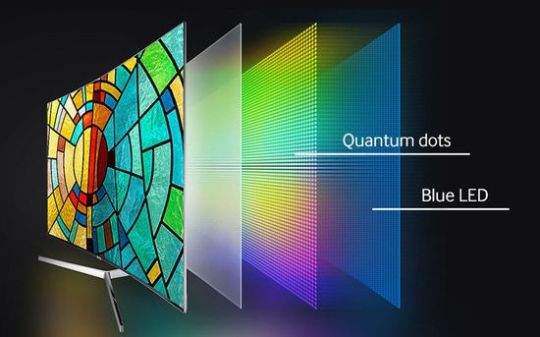
Quantum Dots technology
Improving the white quality significantly increased brightness, color gamut, and color accuracy.
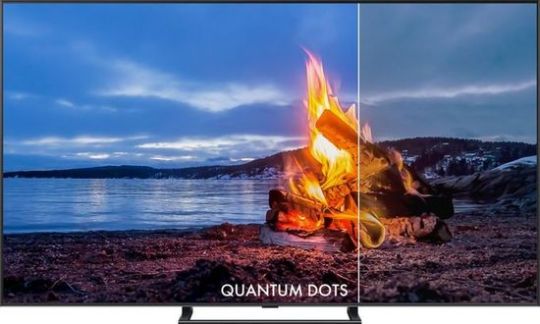
Quantum Dots image quality
OLED & Micro LED panels
As known, OLED technology uses self-emitting diodes and does not require backlit. Due to the lack of backlit scattered light, they provide perfect blacks and thus excellent contrast (max white to black ratio).

OLED vs LED LCD TV image quality
Unfortunately, they are not very bright, and their price is highly dependent on the OLED panel size. For example, the 48-inch LG OLED CX with stunning picture quality costs less than $ 1,300 today. But OLED TVs with large screens are still expensive.
To avoid this problem, some companies are actively developing the direction of Micro LED panels based on modules. Like OLED models, they use self-emitting LEDs without backlit. Of course, such a design, in principle, does not limit the panel size, and allows developers to create screens of any shape in the future. At CES 2019, Samsung even showed 13-inch modules for such panels.

Samsung Micro LED modul
This technology dominates today in terms of image quality, but is prohibitively expensive. For example, at CES 2021 Samsung unveiled the latest 109-inch MicroLED panel, which will cost around $ 156,000.

Samsung Micro LED panel CES 2021
Local dimming based FALD (Full Array Local Dimming) & innovative Mini LED backlit.
This technology controls the brightness of the backlit in different areas of the frame depending on the content, increasing the image contrast.

Local Dimming technology
Innovative Mini LED backlit technology uses miniature LEDs, the size of which allowed developers to increase their number to tens of thousands. They are combined into thousands of local dimming zones with separate control, providing dimming control for each zone. Probably Mini LED technology can be positioned as the latest generation of local dimming with FALD.

Mini-LED technology
At CES 2021, industry leaders unveiled Samsung Neo QLED, LG QNED and TCL OD-Zero TVs with Mini LED backlit. In March TCL announced a fantastic 85-inches TCL X12 8K Mini LED Starlight with 96,000 LEDs. Its estimated price will be just over $ 15,000. In comparison, the legendary TCL 6-Series Roku TV (2018) used only 86 local dimming zones, providing great contrast.
Samsung Neo QLED TVs and LG QNED TVs are available today.
HDR (High Dynamic Range) technology
HDR uses 10 bit encoding instead of 8 bit, and will display the image with dynamic metadata in mind.
Of course, it's fundamentally different from HDR technology in photography, based on the processing a series of shots for one frame with different shutter speeds. In this case, the digital processing algorithm selects from a series a frame with an optimal exposure for each fragment, forming from them something like a Frankenstein-frame.

HDR foto
Unlike 8-bit color depth coding, 10 bit coding expands the number of displayed shades from 16.7 million to 1.07 billion for each pixel (extended color space Rec. 2020).

10bit vs 8bit
As a result, the image quality is dramatically improved.

HDR image quality
Depending on the format, content can contain static or dynamic metadata with information about light level, peak and average frame brightness, colors, etc.
Main HDR formats:
- HDR10 - 10 bit signal with static metadata;
- HDR10+ - 10 bit signal with dynamic metadata;
- HLG (Hybrid Log-Gamma);
- Dolby Vision - premium HDR version with 12 bit color depth (TV must have a special chip).
Many viewers after HDR format psychologically cannot return to SDR, the quality of which seems to them too dull and faded. As a result, over the past few years, the number of HDR fans has grown like an avalanche. In theory, owners of HDR TVs should just be enjoying a great picture. But the internet is filled with questions like “Should I turn on HDR on my TV?”, “Should I have HDR on or off?” “How do I turn off HDR?”, “Is HDR better than HD?”, “Is HDR a gimmick?", "Does HDR really make a difference?", etc. Of course, this situation is not entirely adequate and requires analysis.
"HDR Ready"
Like 4K resolution, the huge popularity has played a cruel joke with a new and, of course, excellent technology.
Several years ago, some manufacturers and sellers of TVs and projectors did not quite correctly began to use the term "4K compatible" or "4K Ready" in the specs of even very budget models. Of course, many consumers interpreted it as the ability of the model to reproduce in 4K resolution, but in reality it corresponded only to the ability to receive 4K content. Having received such a signal, device does downscaling up to the native real panel resolution. In fact, "4K Ready" slightly expands the range of available content. But consumers quickly sorted out this situation and began to pay attention to "native resolution", which really characterizes the panel's capabilities.
Of course, in general, companies behave correctly and do not use such manipulations. For example, Epson projectors use e-shift technology, which slightly, but really increases the perceived resolution by duplicating pixels.

e-Shift
Today, a similar situation exists with HDR technology. Specs of even budget models often contain "HDR: HDR 10, HLG, Dolby Vision, etc". But, of course, an inexpensive and not very bright 8 bit panel without WCG (Wide Color Gamut) support basically cannot reproduce the HDR spectrum. In fact, these TVs only have a chip that decodes HDR content, but plays in SDR quality, disappointing user expectations. Without this chip, TV reproduces HDR format as stripes or black background.
Real HDR requirements
This technology provides full quality while meeting two requirements:
- TV with bright and quite expensive 10bit panel, WCG (Wide Color Gamut) support, and with HDMI 2.1 (High Definition Multimedia Interface);
- HDR content.
To some extent, Wide Color Gamut (WCG) technology can be positioned as the predecessor of HDR and is a software-based color enhancement method.
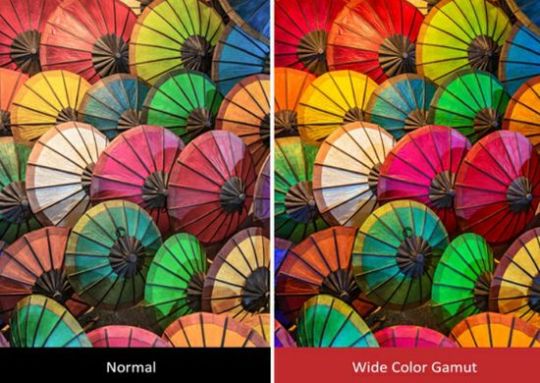
WCG
In fact, it complements HDR. Simplistically, HDR improves the dynamic range of a picture (with brighter brights and darker darks), WCG increases the quality of colors - redder reds, bluer blues, greener greens, etc. In other words, HDR improves image clarity quantitatively, while WCG does so qualitatively. Together they provide an amazing HDR effect.
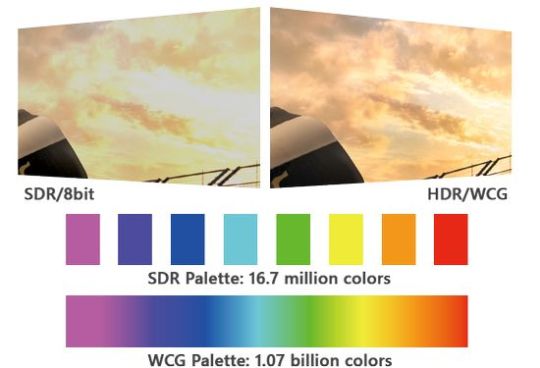
HDR+WCG
Of course, 10 bit panels provide the best HDR quality, but they are expensive. Therefore, many companies use more affordable active 8 bit + FRC panels with lower HDR quality. Frame rate control (FRC) is a method for enhancing color depth in TFT LCD displays. FRC uses a cycling between different color shades for each new frame to simulate an intermediate shade.

8 bit+FRC panel
Of course, the required memory of HDR content is radically higher compared to SDR. Accordingly, its transmission to TV requires a very wide bandwidth. For example, the transfer of dynamic metadata requires a model with HDMI 2.1 support. For comparison, the bitrate of HDMI 1.4 is 10.2 Gbps, HDMI 2.0 - 18 Gbps, HDMI 2.1 - 48 Gbps. Unfortunately, modern budget and many mid-budget models do not support it.
Conclusion
Full playback of HDR content requires:
- high peak brightness (about 1,000 nits);
-10 bit or at least 8 bit + FRC panel with WCG support;
- HDMI 2.1 support (HDMI 2.1 input).
Unfortunately, manufacturers do not always indicate panel type, WCG support and peak brightness in specs. In order to avoid disappointment, it's better to choose a HDR TV based on an objective assessment of their HDR performance in reviews on well-known sites (CNET, Digital Trends, etc) that test many popular models.
Of course, visual assessment without instruments is also possible, but it will be objective only in the side-by-side mode, which requires two identical models. Otherwise, TV can just display content well due to QD technology, local dimming, etc. Even worse, the HDR mode can even degrade the playback quality, for example, due to insufficient brightness. Of course, this situation requires disabling it in the settings.
This video showcases HDR performance of Samsung 4K QLED HDR 1500.
Read the full article
#8bit+FRCpanel#e-shifttechnology#FALD#FrameRateControl#full-arraylocaldimming#HDMI2.1#HDRtechnology#LGQNEDTVs#LocalDimming#MiniLEDbacklit#OLED&MicroLEDpanels#QuantumDottechnology#Samsung4KQLEDHDR1500#SamsungNeoQLEDTVs#TCLOD-ZeroMiniLEDbacklit#TCLX128KMiniLEDStarlight#WCGtechnology#WideColorGamuttechnology
0 notes
Text
All TCL TVs 2021 Review
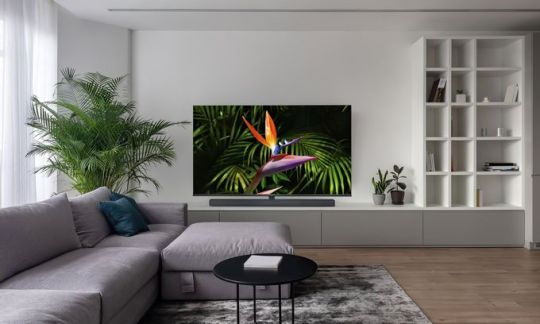
Pronounced innovative orientation, aggressive pricing strategy and high quality have ensured the Chinese giant TCL Electronics to break into the top three in the LCD TVs segment. Probably the phenomenally popular TCL 6-Series Roku TV (2018) with Contrast Control zones technologycan be considered the start of this success. In 2018, TCL sold nearly 30 million LCD TVs (nearly 12% of the global market), beating South Korean giant LG. Of course, Samsung continues to dominate with a market share of over 25%, but at the end of 2Q 2020 TCL is confidently holding its second place.
The innovative success is also impressive. For several years the company has developed three generations of innovative Mini LED backlights, including:
- Contrast Control Zones technology in TCL 6-Series Roku TV 2018;
- Mini LED Quantum Contrast technology in TCL 8-Series Roku TV 2019;
- Vidrian "Glass on LED” Mini LED backlight at CES 2021;
- OD-Zero (Optical Depth Zero) Mini LED technology at CES 2021.
Therefore, the huge consumer market interest in TCL TVs is more than natural.
Basically, 2021 range of TCL TVs will complete with QLED panels and Mini LED technology, Google TV, TikTok, HDMI 2.1, Onkyo sound and more features. C72, C72 + and C82 series are for the UK.
Today their assortment covers almost all price segments. Many series use the innovative Mini LED backlight.
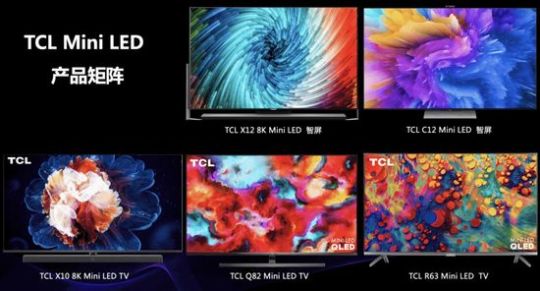
TCL Mini LED TVs 2021
In the article, the prices of TVs are taken from the company's website, which are usually higher than street prices. For example, the price of 55-inch 6-Series (R635) QLED TV on the website reaches $ 800. But some sellers offer it for $ 650.
TCL 3,4 and 5-Series
The lineup starts with TCL 3-Series HD Smart TVs. 32 "/ 40" models (S330) with Android TV cost $ 160 / $ 220, 32" TV (S335) with ROKU TV costs $ 160.
Then, list contains TCL 4-Series 4K UHD HDR (S435) with Roku TV and direct backlight, but with 60Hz native refresh rate only. This series has only three HDMI 2.0 ports, does not use Quantum Dot technology and does not support Dolby Vision or Dolby Atmos. But on the company's website, it starts at unprecedented $ 290 for the 43-inch model, and ends with $ 1,600 for the 85-inch model.
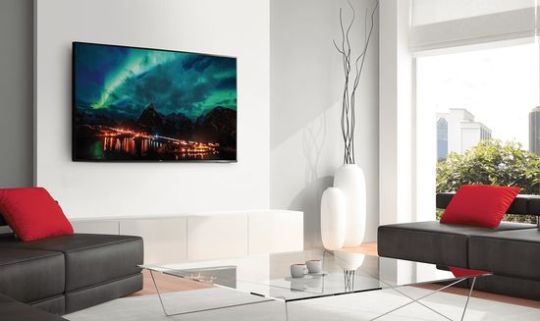
TCL S435 lifestyle TV
The next TCL 5-Series QLED Roku Smart TV today is one of the cheapest QLED TVs on the market. On the TCL website it costs $ 500 for the 50-Inch version (TCL 50S535) and $ 1,000 for the largest 75-Inch model (TCL 75S535).
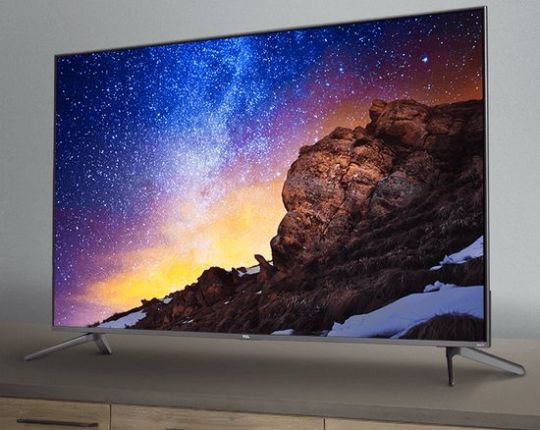
TCL 5-Series (S535)
This series has 60Hz QLED panel, FALD (full array local dimming) with 80 local dimming zones, uses Roku TV platform and supports HDR, HLG and Dolby Vision (no HDR10+). The AiPQ Engine Gen 2 processor provides 4K upscaling and effectively optimizes color, contrast, and clarity for 4K HD.

TCL AiPQ Engine
Unfortunately, color saturation is not very high due to its relatively low brightness (450 nits of peak brightness).
TCL 6-Series
TCL 6-Series (R635) continues this list. Today models in this legendary series are priced at $ 800 / $ 1,100 / $ 1,600 for 55, 65 and 75-inch TVs, respectively.

TCL 6-Series (R635)
According to many experts, it continues to lead in terms of price-to-performance ratio, claiming to maintain its place among this year's bestsellers.
In fact, only the brightness of around 700 nits in HDR and the lack of HDMI 2.1 are adequate for the price. Other specs including Contrast Control zones with Mini LED backlight (up to 240 local dimming zones), Quantum Dot color, high quality 4K upscaling for HD content with new AiPQ Engine, AirPlay and VRR (Variable Refresh Rate) support, fast-response Auto Game Mode , Voice Control (Siri, Alexa and Hey Google), and THX Certified Game Mode for 1440p @ 120Hz gaming clearly exceed this price segment.
Today TCL 6-Series QLED (R635) of 2020 is the latest. But at CES 2021, the company announced the expansion of series with the new R648 8K model. It may well become one of the most affordable premium TV. 8K QLED with Mini LED will provide better contrast, better color and high resolution, and Roku TV & HDR, HLG, Dolby Vision support will round out its pros. Even if the price increases by a few hundred, it will be the cheapest 8K TV on the market.
TCL 8-Series Roku TV 4K HDR (2019)
This series includes a 65-inch model for $ 2,000 (street price $ 1,650) and a 75-inch TV for $ 3,000.

TCL 8-Series (Q825)
It has QLED panel with the best Mini LED backlight, which contains 25,000 individual high-performance mini-LEDs combined into 1,000 control zones. The company calls it Quantum Contrast technology. The TV shows excellent HDR performance.

TCL 4K with Dolby Vision HDR
AiPQ effectively supports three core picture quality algorithms, including Smart HDR for vibrant color, Smart 4K Upscaling for sharp clarity, and Smart Contrast for dramatic depth. In addition, the 8-Series supports Dolby Vision & Dolby Atmos, and HDR Pro Gamma.
But unlike other TCL series, which are usually cheaper than competitors, its price in line with the prices of models from other manufacturers with similar specs. On the other hand, 1,000 control zones is still a record.
TCL C71 & C81 QLED TVs
In UK and Europe are very popular TCL C71 & C81 QLED TVs.

TCL C71 & C81 QLED TVs
Their price:
- C715 - £400 / £550 / £700 for 50, 55 and 65-inch models;
- C815 - £640 / £1,370 for 55 and 65-inch models.
C81 uses QLED panel with edge-lit, Android TV (9.0) and supports HDR10, HLG, Dolby Vision and HDR10+.
Out of the box, C81 supports Google Assistant voice recognition and Google Chromecast. Android offers Netflix, Amazon Prime Video, YouTube, etc with 4K and HDR support.
The list of its pros includes QLED technology, native 4K resolution, good value, powerful, forward-facing sound system, colorful image and super-slim outer edge due to edge-lit instead of direct backlight. But traditionally for an edge-lit VA panel, it has relatively low viewing angles and backlight clouding. In addition, it has only three HDMI without HDMI 2.1 features. Accordingly, TV does not support VVR, eARC, ALLM (automatic low latency mode) and 4K@120Hz. However, this is quite adequate for its price.
The popularity of this series is primarily due to the ratio of price and quality. At a near-budget price point, the TV has a premium design, great sound and good functionality. The soundbar with a rear woofer perfectly plays movie soundtracks, including Dolby Atmos.
TCL C72 / C72+ and C82-Series
TCL promises C72 / C72+ and C82 Series with Mini LED backlight and HDMI 2.1 / VRR this year.
Tentatively, the 55-inch and 65-inch C825 will be priced at £ 1,099 and £ 1,499 respectively.
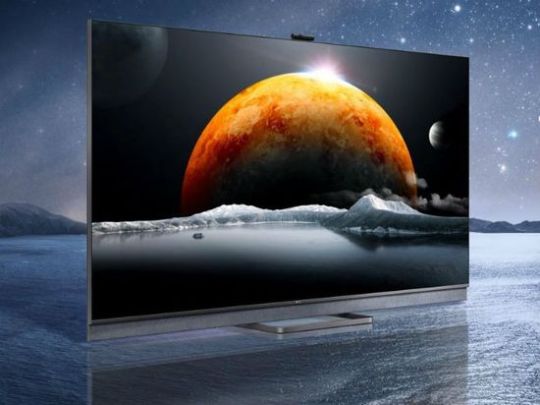
TCL C825 4K Mini LED TV
Considering the Mini LED backlight compared to the edge-lit in the C81, the price increase is quite adequate. In fact, C825 series is a QLED 4K HDR TV with Mini LED based on the Android TV smart platform. Like the C81, it supports HDR10, HLG, Dolby Vision and HDR10+.
The C825 uses a 100Hz Motion Clarity Pro panel, supports HDMI 2.1, VRR and eARC. Also, it has integrated ONKYO 2.1 sound system, Game Master Pro, "magic camera" for Google Duo video calls, built-in Google Assistant and hands-free voice control.
In addition, the series has Dolby Vision IQ feature that automatically optimizes brightness and contrast settings based on light sensor data (depending on ambient lighting).
A magnetic split-type camera (4M Pixel) is for video conferencing.
Cheaper series:
- C72 (43, 50, 55, 65, 75in) - QLED, AiPQ engine, Dolby Vision, Dolby Atmos, Google TV, Freeview Play.
- C72+(55, 65, 75in) - QLED, AiPQ engine, 100Hz Motion Clarity Pro, Dolby Vision IQ, Game Master Pro, HDMI 2.1 with VRR, UHD 120 HDR, Freeview Play.
X12 & C12
The flagship TCL X12 8K Mini LED Starlight Smart Screen with the latest OD-Zero Mini LED backlight closes current lineup.

TCL X12 8K OD-Zero Starlight Smart Screen
X12 and C12 Quantum Dot Mini LED Smart Screen were announced on March 9th at the Spring News Online Conference.
The C12 includes 65" and 75" models.

TCL C12 Quantum Dot Mini LED Smart Screen
Its backlight uses 3840 LED chips with a size of 228 µm for the 75" model, and 3200 for the 65" TV. Their preliminary cost is 17,000 CNY ($ 2,625) and 13,000 CNY ($ 2,000), respectively.
The C12 delivers 1,000 nits peak brightness and 10,000,000: 1 contrast.
The new OD-Zero miniLED of flagship TCL X12 8K uses an unprecedented 96,000 LED chips grouped into 1920 local dimming zones. OD-Zero panel thickness does not exceed 9.9 mm. The diagonal of this Chinese miracle is 85 inches at amazing brightness of 2000 nits, a contrast of 10, 000, 000: 1, and an ultra-high color gamut of 157% (BT.709). In addition, the model has a theater-level Onkyo 5.1.2 Hi-Fi audio with 8 channels, 25-unit speakers and subwoofer unit with a cavity of 7 liters. Its 48MP 3D ToF camera very accurately recognizes air gestures and the distance between person and TV.
Estimated price will be ~ $ 15,000.
Some sources quote a ridiculous price of $ 1,500. Perhaps this is due to the identical typographic symbol (¥) for yuan and yen. Of course, ¥ 99,999 Chinese Yuan (CNY) is significantly different from ¥ 99,999 Japanese Yen (JPY) (1 CNY ~ 16.9 JPY).

TCL X12 8K OD-Zero price
Maybe we're wrong. But if someone offers the TCL X12 8K for $ 1,500, perhaps Samsung, LG and other TVs makers will have to retrain to make toys and diapers.
Conclusion
Probably innovative Mini LED backlight has become the main trend of this year in the segment of LCD TVs. Samsung and LG introduced Samsung Neo QLED and LG QNED series with this technology. Of course, TCL did not stand aside, introducing the fantastic OD-Zero technology based on miniature LEDs measuring 151 microns.
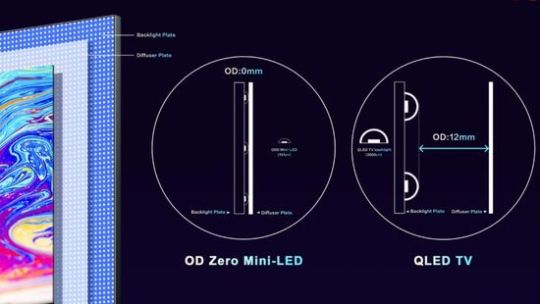
OD Zero mini LED size
As a result, the lines of all the leaders have expanded with a new generation of LCD TVs with Quantum Dots technology and mini LED backlight. But unlike the competition, TCL already has an 8-series with this technology.
Despite fierce competition, the continuation of the legendary 6-Series, the expansion of very popular in Europe 71 and 81 series, and the announcement of the 85-inch X12 8K with OD-Zero backlight, allow the company to feel very confident.
Given the huge assortment in almost all price segments, fans of this brand can easily choose the optimal model depending on preferences and budget.
This video contains full specs of the new TCL X12 8K Mini LED Starlight.
Read the full article
#LGQNED#OD-ZerominiLEDbacklight#SamsungNeoQLED#TCL3-Series#TCL4-Series#TCL5-Series#TCL50S535#TCL6-Series#TCL75S535#TCL8-Series#TCL8-SeriesQ825#TCLAiPQengine#TCLC12QuantumDotMiniLEDSmartScreen#TCLC71QLEDTV#TCLC72QLEDTV#TCLC81QLEDTV#TCLC82QLEDTV#TCLC825#TCLR635#TCLR648#TCLTVslineup2021#TCLX128KMiniLEDStarlight
0 notes
Text
Innovative eye protection technologies when working with display Review
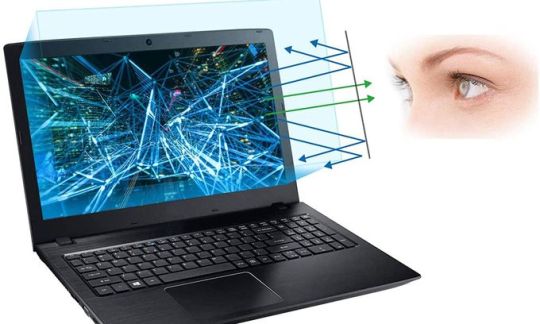
The digital revolution has kicked off explosive growth in the consumer electronics segment, including PCs, smartphones, tablets, etc. As a consequence, people began to spend significantly more time at the displays. Unsurprisingly, many have started talking about display safety in the context of eye fatigue.
The range of factors is wide enough and includes blue spectrum, glare, screen flickering, etc. Of course, they all have key features. For example, fast response time and high frame rate are important for gamers because input lag is accompanied by image trail that reduce detail.
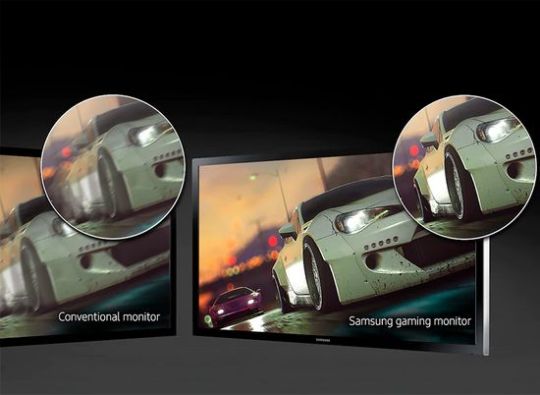
response time
Interference due to poor quality upscaling in budget TVs also reduces image clarity, increasing eye fatigue. Of course, the article format does not provide for a complete list of all factors, limiting itself to only a few of them.
Flicker-free & blue filtering
As known, PWM (pulse width modulation) is one of the most effective technologies to adjust brightness. Unfortunately, its operation principle inevitably causes screen flickering, which negatively affects about 30% of people, provoking eye fatigue and even headaches.
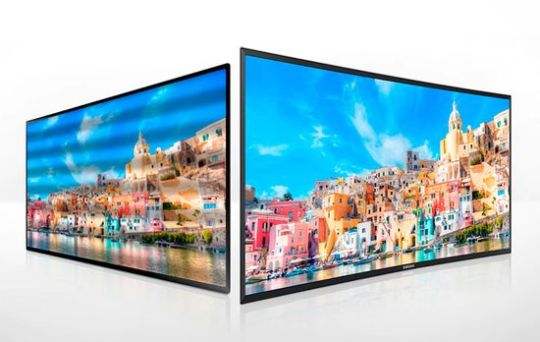
conventional vs flicker-free screen
Flicker-free technologies are based on combined control, using PWM only at low brightness levels.
Blue filtering technologies are the next most popular among display manufacturers. The problem in this spectrum range is associated with the short wavelength of blue. As a result, partially dissipating in front of the crystalline lens, blue reduces image clarity and increases eye strain, causing increased eye pressure. With prolonged exposure, this effect can provoke fatigue, headaches and even myopia over time.

Protecting eyes from blue
To eliminate this problem, manufacturers partially filter the visible spectrum in blue range. The companies use different names for these technologies. For example, ASUS calls its technology Ultra-low Blue Light, BenQ - Low Blue Light, Samsung - Eye Saver Mode, etc.
Unfortunately, this filtering causes color distortion, reducing color accuraty. To compensate for this, companies are developing optimal modes for different content. In addition, almost all devices have an adjustment of filtration intensity.
Other eye protection technologies
Suboptimal brightness and contrast settings also increase eye fatigue. For example, too dark or too bright image reduces its detail. By optimizing this balance, companies develop modes with optimal settings for different content (Cinema, Vivid, Standard, etc). But, of course, local dimming technology is most effective today for adjusting brightness in different areas of the frame.
Moreover, this year has become a watershed for LCD displays. At CES 2021 Samsung, TCL and LG unveiled super innovative Neo QLED, OD-Zero and LG QNED models with miniLED backlight.
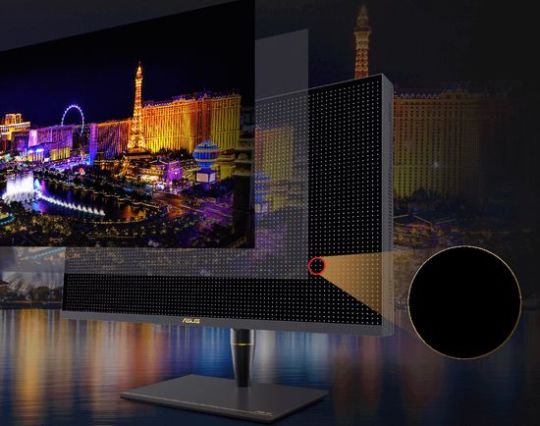
Mini-LED technology
It uses a huge number of miniature LEDs that are combined into thousands of local dimming zones. According to experts, the contrast of the new LCD miniLED TVs can come close to the ideal contrast of expensive OLED panels, the self-emitting LEDs of which operate without backlight.
High display brightness at low ambient light also increases eye fatigue. Therefore, many modern displays have a light sensor, based on the data of which the system automatically adjusts the brightness. For example, BenQ solves this challenge with B.I.+ (Brightness Intelligence Plus) technology.
The matte screen and various anti-glare technologies (Acer ComfyView, etc) also reduce eye fatigue.
According to some ophthalmologists, the curved display provides the same distance for different screen parts, reducing the eye strain for focusing.
Some companies use original names for various combinations of these technologies, such as BenQ Eye-care or Acer VisionCare.
Gamer monitors
As a rule, adults independently regulate eye fatigue, periodically taking breaks from work. But teenagers are often addicted to games, forgetting about this aspect. Therefore, eye protection is especially relevant in gamer monitors. Of course, the list of models with effective protection is quite wide. But some companies pay special attention to it.
The 49-inch Samsung C49HG90DMI (LC49HG90DMIXCI) with a curved SVA panel and DFHD (3840 × 1080) resolution has a 32: 9 aspect ratio, which is identical to two 27-inch panels with a 16: 9 aspect ratio. It supports the simultaneous display of two images from two different sources.
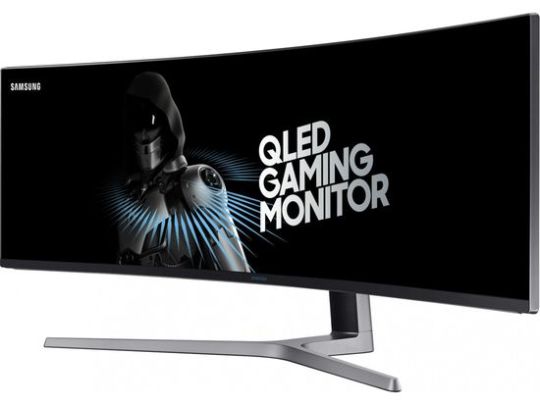
Samsung C49HG90DMI (LC49HG90DMIXCI)
MagicBright technology optimizes brightness based on content, Eye Saver Mode filters out blue, PWM-free backlight eliminates flicker.
Dell UltraSharp U4919DW is one of its main competitors today. With a similar 32: 9 aspect ratio, it has a Super UltraWide (5120 x 1440) resolution and a 3800R vs 1800R curvature for Samsung.

Dell UltraSharp U4919DW
ComfortView filters blue. It also has flicker-free IPS panel and AR (anti-reflective) coating.
The 31.5-inch ASUS ROG Strix XG32VQR with VA panel and WQHD (2560 x 1440) resolution has 1800R curvature and 4 ms response time.
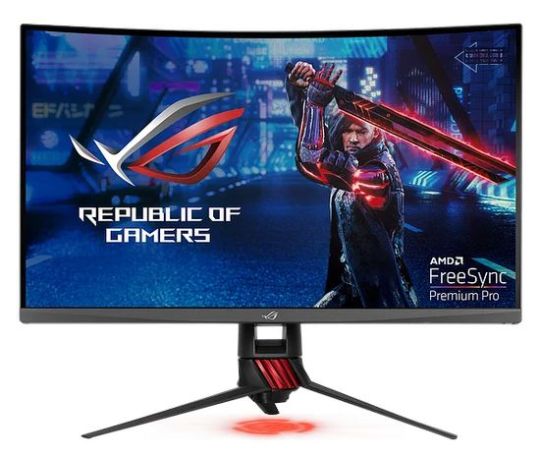
ASUS ROG Strix XG32VQR
The company uses Flicker-free, Ultra-Low Blue Light (4 modes) and Shadow Boost (improved black detail) in this model.
The more affordable Acer R240HYAbidx (UM.QR0EE.A01) with excellent brightness / contrast settings out of the box uses the VisionCare, including Flicker-Less, Blue Light Filter and anti-glare ComfyView.
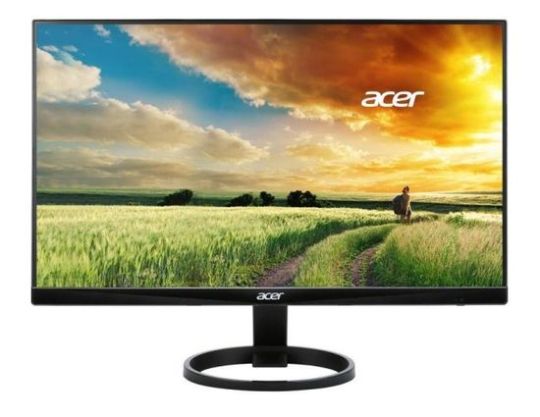
Acer R240HYAbidx (UM.QR0EE.A01)
BenQ is also active in the development of eye protection technologies. Its Eye-care includes Low Blue Light+ (blue light filter), flicker-free WLED backlight, Brightness Intelligence color correction system (increases saturation with decreasing brightness), and automatic screen brightness adjustment based on ambient light.
Conclusion
Today, a rather heated discussion continues between ophthalmologists about the optimal image resolution and contrast, the danger to the eyes of the blue spectrum, glare, screen flickering, etc.
But despite the heated debate, many companies prefer to play it safe by making efforts to minimize these risks. For example, many smartphone manufacturers are actively expanding their range with flicker-free models. Moreover, the Chinese giant Xiaomi recently developed DC Dimming technology, which virtually eliminates this unpleasant effect.
Perhaps this trend is partly due to marketing considerations. Of course, eye protection technologies significantly increase the competitiveness of their products. But on the other hand, reducing risks to vision is objectively beneficial also to consumers.
This factor is especially important when choosing model for teens, who are usually less attentive to their health.
This video demonstrates HDR performance improvement with B.I.+ (Brightness Intelligence Plus) technology in BenQ Eye-care EW3270U 4K gaming monitor.
Read the full article
#AcerComfyView#AcerR240HYAbidx(UM.QR0EE.A01)#AcerVisionCare#ASUSROGStrixXG32VQR#ASUSultra-lowBlueLight#BenQB.I.+technology#BenQBrightnessIntelligencePlustechnology#BenQEL2870U#BenQEye-careEW3270U#BenQLowBlueLight+#DCdimmingtechnology#DellUltraSharpU4919DW#eyeprotectiontechnologies#flicker-freescreen#miniLEDbacklight#SamsungC49HG90DMI(LC49HG90DMIXCI)#SamsungEyeSaverMode
0 notes
Text
Siemens EQ 300 vs Siemens EQ 3 Review
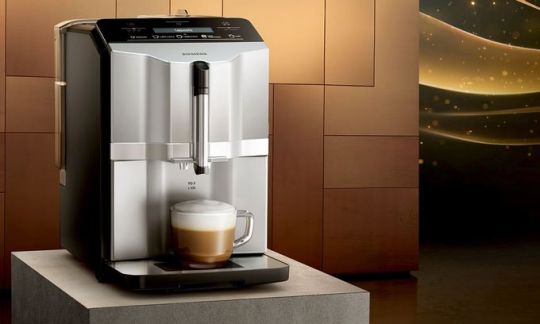
As known, mergers, acquisitions and purchase of brands are traditional business tools. But as a result, users sometimes get confused about brands. For example, consumers sometimes ask which is better - Bosch vs Siemens (refrigerator, coffee machine, etc)? But a short explanation will help clear up this confusion.
BSH ("Bosch and Siemens Hausgerate") was formed in 1967 as a joint venture for the production of household appliances with the participation of Robert Bosch GmbH (Stuttgart) and Siemens AG (Munich) companies.
Today BSH operates 45 factories in 15 countries in Europe, USA, South America and Asia and unites 14 brands. Therefore, Bosch and Siemens coffee machines differ only in design and some minor functions. In fact, the entire lineup under the Bosch brand has complete Siemens counterparts. Curiously, many analogs under different brands differ in price by 5-10%. Of course, in these cases, price and discount become the main selection criteria.
These coffee machines are manufactured by an OEM (original equipment manufacturer) Eugster / Frismag company. As known, OEM companies produce parts and equipment that can be sold to other manufacturers under a different brand name. For example, Acme Manufacturing Co manufactures power cords for IBM and is an OEM. In particular, Eugster / Frismag produces also coffee machines under the brands Jura, Melitta, Miele, Nivona, etc.
Siemens EQ.3 and Bosch VeroCup series
EQ.3 line appeared as a budget Siemens series on a new platform in 2017. It includes s100 (TI301509DE), s300 and s500 models. It can hardly be positioned as compact, but its dimensions are significantly smaller compared to the EQ.6 and EQ.9 series.
A year later, the range expanded with a similar Bosch VeroCup series, including the VeroCup 100 (TIS30159DE), 300 and 500, which has slight differences in design, but is significantly cheaper. But at the same time, the nuances of finishing the front panel are the only difference between, for example, Bosch VeroCup 100 and Siemens EQ.3 s100.

Bosch VeroCup 100

Siemens EQ.3 s100
The differences between s500 and s300 are also insignificant.
Siemens EQ.3 s500 vs s300:
- added a sixth DoubleShot strength, which uses two grinds to make a double espresso;
- black glossy upper part of the front panel instead of matte silver.
The differences between s100 and s300 are more significant.
Siemens EQ3 s100 vs s300:
- 3 vs 5 grind settings;
- no screen;
- 3 vs 5 strength settings;
- no "2 portions" button;
- no portion counter.
Siemens EQ.300
In 2019, the company introduced the new Siemens EQ.300 series. But only two additional zeros in the name and the stripe color became the main difference of the "new" models.

Siemens EQ.300 vs EQ.3
It seems that the company's management is quite satisfied with the situation and has decided not to change anything in its budget series. Perhaps conditionally "new" series is designed to solve marketing problems, demonstrating the continuous development of budget Siemens (Bosch) coffee machines. On the other hand, the prices of the new models have also remained virtually unchanged.
Specs:
- unusual ceramic coffee grinder with three grind settings uses only one bottom milestones and a pressure steel plate on top. But in the event of a breakdown, according to the regulations, the entire unit is replaced as an assembly. This decision seems controversial;
- the pump provides up to 15 bar;
- 1300W flowing thermoblock;
- the screw brewing unit holds from 5 to 14 grams of coffee.

Siemens EQ.300 brewing unit
Unfortunately, not very strong plastic is sensitive to mechanical stress and can deform, for example, when solid particles enter. Therefore, the brewing unit requires frequent rinsing under the tap and regular lubrication at least once every 200 cycles.

Siemens EQ.300 Care
Otherwise, the screw mechanism will jam. Moreover, the abrasion of the plastic in the places of the most intense friction makes it unrepairable. Of course, service centers solve this problem, but costs are inevitable;
- coffee bean hopper - 250 grams;
- water tank - 1.3 liters;
- coffee cake container - 10 servings.
- 3 strength settings without temperature adjustment.
New models have LED indicators instead of a screen, do not provide two cycles in a row and do not use pre-ground coffee.
Milk frother
Five direct-launch touch buttons on the front panel are for espresso, coffee crema, cappuccino, latte macchiato and milk.

Siemens EQ 300 Buttons
The company positions milk frother as automatic. But its design is similar to the manual Panarello.

Siemens EQ 300 Steam wand
It's manually lowered to the required height in the cup, whips milk with steam and washes under running water. The optimum immersion height is just below the milk level in the cup.
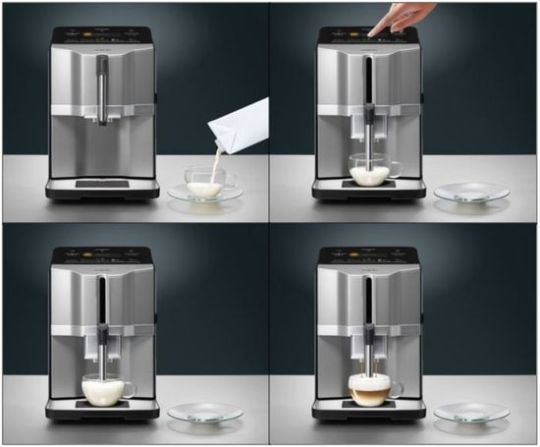
Siemens EQ 300 Cappuccino
Probably, it's more in line with the semi-automatic model. Accordingly, the amount of milk in a portion is not programmable and depends on your tastes.
The volume of espresso and lungo varies in the range 25-60 ml (default 25 ml ) and 80-200 ml (default 80 ml), respectively.
In fact, milk frother is a Steam wand, which is combined with a coffee dispenser in one module.
Raf coffee is an unexpected plus of this milk frother, which can whip milk in a cup with coffee. The recipe for this popular coffee drink is quite simple. The 10% cream, 5-15 grams of vanilla sugar and a little syrup are added to the espresso and whipped using the Milk program.
Analogue EQ.3 s500 has no active cup warmer on top, offers 3 vs 5 grind settings, 5 vs 3 strength settings, has a start button for two cycles in a row and a two-line text screen.
Conclusions
In fact, Siemens only formally updated the popular Siemens EQ.3 line, offering a similar budget EQ.300 series. Probably the limited range of programs, the lack of mechanical reliability of the screw brewing unit and the dubious design of the new coffee grinder with only bottom milestones are essential cons for the middle and premium price segments. But they are quite adequate for the budget range. Given the low price and impeccable German quality of parts and assembly, Siemens EQ.300 coffee machines are more than competitive.
But considering the almost complete identity of Bosch VeroCup, Siemens EQ.3 and Siemens EQ.300, price and discounts become the main criteria for choosing the optimal model from these series.
This video introduces Siemens EQ.300.
Read the full article
#BoschVeroCup100#Rafcoffee#SiemensEQ.3s100#SiemensEQ.3s300#SiemensEQ.3s500#SiemensEQ.3series#SiemensEQ.300series#SiemensEQ.300vsEQ.3#TI301509DE#TIS30159DE
0 notes
Text
Sony Bravia XR A90J - best OLED 4K TV? Review

At $ 2,800 for the 55-inch XR55A90J model and $ 3,800 for the 65-inch XR65A90J TV, the Sony A90J can be positioned as the closest competitor to the new LG G1 OLED 4K TV with innovative Evo panel. It's slightly beterr in terms of video and audio quality, but inferior to the South Korean model in terms of advanced gaming features and price, which is $ 3,000 for a 65-inch TV.
Stylish designs, including bezel-free borders, ultra-slim form-factor and brushed-metal remote, are all premium.

Sony Bravia XR A90J Design
Of course, convertible stand with three options for leg placement is one of the main pros of its design.
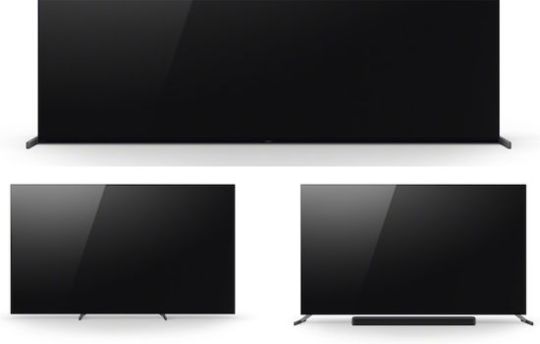
Sony Bravia XR A90J Legs
This 2-way multy-position stand provides:
- placement above soundbar (max height);
- inverted legs (min height, tight fit to the media device without a gap);
- adjustment of the distance between the legs (the legs move toward the middle of the TV, which is often very convenient).
Google account and the Google Home app in the new Chromecast with Google TV provide a very simple and quick setup. Today Google TV offers 700,000+ movies and TV episodes, live TV and other content from Netflix, Amazon Prime Video, Disney+, YouTube, the Apple TV app, etc.
Of course, the model uses all of Sony's innovations, including the XR Triluminos Pro display, XR OLED Contrast Pro PRO, XR 4K upscling, and supports Dolby Vision, IMAX Enhanced, Netflix Calibrated mode, Google Assistant and Apple Airplay.
Video & Audio
The video signal processing quality has also risen to a new level. For the first time the company uses a revolutionary processing technology called Cognitive Processor XR.

Sony Bravia XR A90J Cognitive Processor XR

Sony Bravia XR A90J Setting

Sony Bravia XR A90J Focus
Similar to the brain, the processor divides the screen into hundreds of zones, recognizes and analyzes individual objects in these zones, optimizes focal point, contrast, color and clarity for each zone, and instantly generates the most realistic overall picture. For example, the Sony XR processor can enhance the detail in animal fur without changing it for the background. Perhaps, the company's statements contain some marketing components, but the really excellent image quality fully supports them.
Moreover, a new heat-sink technology for panel allows developers to increase the current without damaging the pixels. This decision nearly doubled the brightness of Sony's new OLED TV, which reached an unprecedented 1300 nits in Vivid mode.
The sound is also unrivaled. As known, Sony places transducers on the back side, turning the screen surface into a speaker. This technology provides precise audio and video synchronization about the screen, dramatically increasing the immersiveness of your viewing experience.

Sony Bravia XR A90J XR Sound Position
Additionally, Voice Zoom 2 detects the type of audio content, optimizing its volume and clarity.

Sony Bravia XR A90J Voice Zoom 2
What's more, XR Surround technology reproduces a 3D surround effect.

Sony Bravia XR A90J XR Surround
Of course, the A90J audio cannot compete with the dedicated sub, but the additional bass driver has significantly improved bass playback. In addition, two speaker terminals on the back of A90J to accept a signal from an A / V receiver allow you to use TV as center speaker.
Picture settings & Gaming
In SDR, High peak brightness setting provides 370 nits peak. The more standard 150 nits of peak brightness setting at low provides ideal color accuracy.
HDR mode actually requires no additional settings, delivering up to 800 nits brightness out of the box, which is great for Custom or Cinema modes.
As usual, the slight inaccuracies of color accuracy begin to appear as peak brightness increases. But at moderate settings, it's almost perfect.
Vivid mode delivers nearly 1,300 nits, but the auto-brightness limiter brings it down to less than 1,000 nits for protection of pixels from overheating. This decision is perfectly reasonable. Of course, Vivid mode is convenient for watching sports channels in bright daylight. But in other cases it looks a little unnatural and inferior to Custom or Cinema modes.
The A90J has two HDMI 2.1 ports with support of 4K@120fps, ALLM (Auto low-latency mode), etc. But one port is for TV's eARC port. When using it, the TV only allows you to connect one HDMI 2.1 device. Thus, eARC must be disabled at parallel connection of, for example, Xbox Series X and PlayStation 5. However, an HDMI 2.1 4K@120fps compatible A / V receiver will solve this problem.
Unfortunately, the model still does not support VRR (Variable Refresh Rate). But according to preliminary information, firmware update from Sony can eliminate this annoying disadvantage.
Sony A90J vs LG G1 OLED Evo

Sony A90J vs LG G1
- 65-inch LG G1 cheaper by $ 800;
- LG G1 Gallery Series is designed for wall mounting and looks great on the wall. In addition, the included flush-mount wall bracket makes this task much easier. 2-way multy-position stand of A90J is ideal for stand mounting;
- the new excellent webOS 6.0 of the LG G1 is on par with the Google TV of A90J with built-in Chromecast;
- LG G1 offers a lot more built-in settings, including the great Gaming Optimizer. But using them effectively is sometimes difficult and requires skill. Overall interactive experience of A90J is simpler and more convenient;
- innovative LG G1 Evo panel provides more accurate and brighter color due to purer red and blue pixels and a more accurate green pixel structure. Combined with the new α9 Gen4 processor, it delivers up to 1,000 nits brightness. New heat-sink technology in A90J increased peak brightness to an unprecedented 1,300 nits in Vivid mode, but the auto-brightness limiter brings it down to 950 nits for pixels protection from overheating;
- Sony A90J with Sony's full suite of audio technologies sounds better, but the LG G1 delivers a wider range of bass;
- test measurements of the LG G1 show 400 nits for SDR, 830 nits in HDR, and 860 nits in Vivid mode. The Sony A90J showcases 360 nits in SDR, 800 nits in HDR, and a unprecedented 1,250 nits in Vivid mode. But when viewing normal content in medium ambient light this difference is practically imperceptible;
- today LG G1 is the best gaming TV with four HDMI 2.1 inputs, 4K@120fps, VRR, G-Sync and FreeSync support out of the box. The Gaming Optimizer completes the list of its gaming pros.
Conclusion
Pros
- innovative Cognitive Processor XR technology;
- brightest OLED TV today;
- excellent HDR performance out of the box;
- great sound with XR Sound Position, Voice Zoom 2 and XR Surround;
- perfect black levels;
- stunning detail;
- convertible stand.
Cons
- $ 3,800 for 65-inch model;
- eARC port uses one of two 4K@120fps HDMI 2.1 ports;
- no VRR (Variable refresh rate) support in games.
Of course, Sony Bravia XR A90J rightfully claims to be the best OLED 4K TV of 2021. Cognitive Processor XR technology can be positioned as the next generation of video processing. Unprecedented OLED panel brightness up to 1,300 nits, near-perfect color accuracy, great sound, a full range of innovative technologies, convertible stand, etc make up an incomplete list of its pros.
Nevertheless, competitors are unlikely to provide an opportunity for the Japanese technological miracle to rest on its laurels. The new LG G1 OLED 4K TV with innovative Evo panel and webOS 6.0 is more than a serious contender. Slightly inferior in video & audio quality, South Korean TV is $ 800 cheaper and is the best gaming TV.
On a high budget, the Sony Bravia XR A90J is ideal for viewing in excellent quality. But the LG G1 is a more pragmatic choice for gamers, who prefer to save money. Either way, the new level of video processing with Sony's Cognitive Processor XR technology will be a great incentive for the competition.
This video showcases the innovative Cognitive Processor XR technology in the latest Sony Bravia XR A90J TVs.
Read the full article
#CognitiveProcessorXRtechnology#LGG1OLEDEvoTV#OLEDEvopanel#SonyBraviaXRA90J#SonyBraviaXRA90JOLED4KTV#SonyVoiceZoom2#SonyXRSurround#XRSoundPosition
0 notes
Text
LG C1 OLED TVs 2021 Review
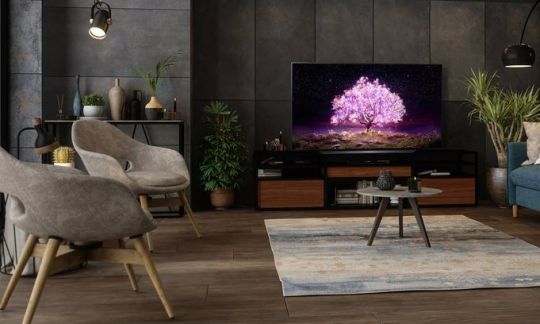
Despite a sensational breakthrough in segment of LED LCD QD (Quantum Dot) TVs with innovative miniLED backlight, OLED TVs continue to dominate in terms of picture quality. As known, LG is one of the main leaders in this direction.
2021 LG OLED lineup includes:
- budget A1 series with a price from $ 1,300 for the 48-inch OLED48A1PUA model to $ 3,200 for the 77-inch OLED77A1PUA TV;
- C1 series starting at $ 1,500 for the 48-inch OLED48C1PUB model up to $ 6,000 for the 83-inch OLED83C1PUA TV;
- the flagship G1 series priced from $ 2,100 for the 55-inch OLED55G1PUA model to $ 4,500 for the 77-inch OLED77G1PUA TV.
In addition, according to the company, the line will expand with the B1 series, will be available for sale later this year. Obviously, B1 TVs will take place between the A1 and C1 series.
LG OLED C series
Traditionally, the C series is the basic and most popular due to the optimal price-performance ratio. As a rule, they provide almost flagship performance, but at the same time they are significantly cheaper. For example, the 65-inch G1 is $ 500 more expensive than the OLED65C1PUA ($ 3,000 vs $ 2,500).
The list of their differences includes two main points. First, the G1 has new built-in Next-Gen (ATSC 3.0) tuner. In addition, the G1 uses an innovative Evo display that is approximately 20-30% brighter. Of course, a peak brightness of up to 1,000 nits (cd / m2) is a significant advantage. But great contrast of OLED TVs comes from ideal blacks rather than high brightness. Of course, it's useful when viewing, for example, on an open veranda in direct sunlight. But most people usually place the TV in a room, and 500-600 nits is enough for ambient daylight. In addition, Dolby Vision IQ function with built-in light sensor controls ambient light and automatically calibrates brightness, significantly reducing this problem. But, of course, HDR quality depends on brightness.
Therefore, the high popularity of the C series is quite justified and claims to become a tradition. For example, LG C7 was one of the most popular OLED TV of 2017. The next year, according to most experts, the LG C8 PLA was the best 4K OLED model of the 2018. The next LG C9 also made the bestseller list. The 2020 LG OLED CX scored nearly 4,000 rave ratings on Amazon and is one of the most popular models today. This year is no exception, and the new LG OLED C1 rightfully claims to take its place alongside the 2020 LG CX series. This series is available in five sizes.
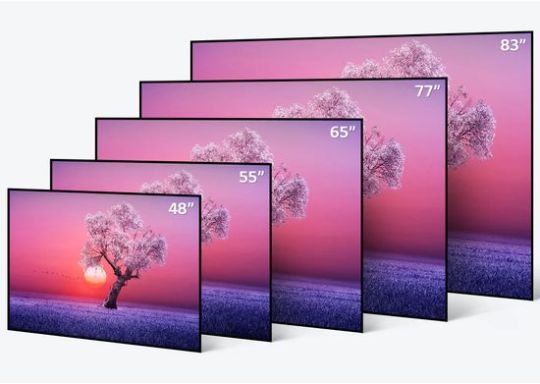
LG C1 OLED TV size
LG OLED C1 vs A1
The differences between C1 and A1 are more significant. With a price difference of several hundred dollars (for example, $ 2,500 for 65C1 vs $ 2,200 for 65A1), the list of differences includes:
- HDMI 2.1 vs HDMI 2.0 - A1 does not support 4K @ 120Hz signals and VRR (variable refresh rate) mode in games.

VRR (variable refresh rate)
- α9 Gen4 vs α7 Gen4 processor - of course, performance affects the quality of video processing;
- 120Hz vs 60Hz refresh.
But according to the company, the A1 will support motion smoothing (Soap Opera Effect).

Soap Opera Effect
- A1 does not support eARC and ALLM (Auto Low Latency Mode).
As known, HDMI ARC is a digital two-channel audio interface, eARC (Enhanced Audio Return Channel) is its improved version. ARC standard is compatible with most receivers and soundbars. It simplifies connectivity, providing audio transmission in both directions. But ARC is not used when using TV speakers without a receiver or soundbar.
ALLM automatically switches the TV to Game Mode with minimal latency when it detects a signal from the console;
- 4 HDMI inputs vs 3 HDMI inputs.
In general, A1 is significantly inferior as a gaming monitor. But for watching movies, it's great.
LG OLED C1 vs CX (2020)
The differences between C1 and CX are even less significant. They are almost identical in design.
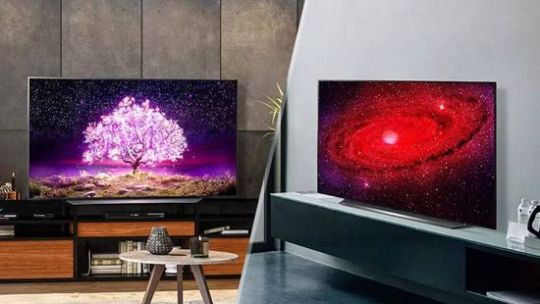
LG C1 vs CX design
The C1 uses the new and more powerful α9 Gen 4 AI Processor 4K vs α9 Gen 3 in last year's CX. Of course, the new α9 Gen 4 is better for upscaling non-4K content. Moreover, the company promises more immersive audio due to better recognition of audio content. Plus, the new model runs on the new webOS 6.0 instead of webOS 5.0. Considering significant progress this platform, this is one of the main advantages of the new series.
At the same time, 55-inch C1 is more expensive than CX by $ 400, and 65- and 77-inch TVs are more expensive by $ 500 ($ 2,500 & $ 3,800 vs $ 2,000 & $ 3,300).
In fact, last year's CX has an obsolete webOS version without the new Magic Remote and is inferior in processor performance. Therefore, the $ 500 difference might seem a little bit excessive. But, of course, a price adjustment by a company can quickly change this situation.
LG webOS 6.0
Of course, the flexibility can be considered a major key feature of webOS. This OS is not affiliated with Google, Amazon or Apple and supports many partners. As a result, the flexible UI and robust customization system makes it one of the most user-friendly to date. Moreover, the company continues to actively improve it. The new 6.0 version has demonstrated significant developer successes.
This list includes:
- new interface full screen.
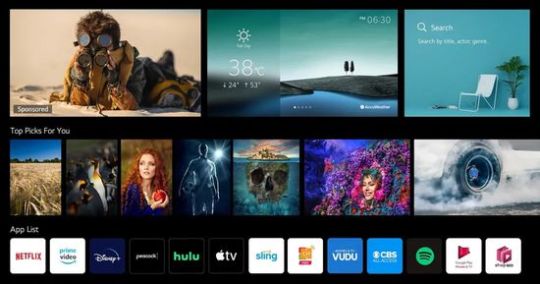
LG webOS 6 interface
- enhanced LG ThinQ AI function.
ThinQ AI home screen offers most frequently used apps and all devices that connected to ThinQ AI.
- Next Pick function;
- Magic Link function expanded to Magic Explorer.
In addition, the C1 uses a new bluetooth-enabled Magic Remote with multiple direct launch buttons, including Google Assistant and Amazon's Alexa.

LG webOS 6.0 Magic Remote
Thus, the viewer can control the UI using Wii-style motion controls or the directional pad, or with four quick launch buttons in the most popular apps. Moreover, new Remote has a built-in microphone for voice searches.
Smart TV:
- every major streaming service (Amazon Prime Video, Netflix, Disney Plus, Hulu, Vudu, Sling TV, Paramount Plus, Apple TV, etc);
- music streaming includes Spotify, Plex, Pandora, Amazon Music and more;
- quick UI with AirPlay and Casting;
- built-in Amazon Alexa & Google Assistant.
Magic Tap mode provides mirror streaming content to the TV with LG phone с поддержкой NFC.
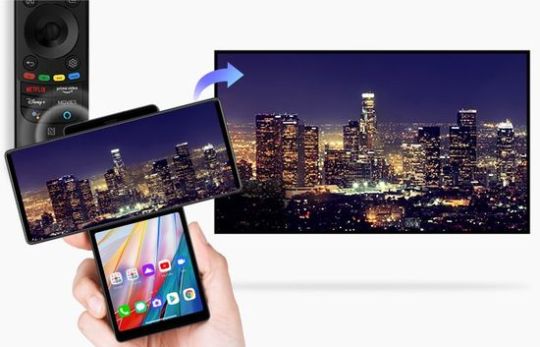
LG C1 OLED Magic Tap
This option also supports reverse mirror content from the TV to phone, including audio.
The new Sports Alert feature will be of interest to sports fans, informing about the schedule of games, their result, etc.

LG OLED C1 Sports Alert
Brightness, upscaling and AI Picture Pro
Peak brightness (10% white window in HDR mode) is just under 900 nits in Vivid mode, which is slightly higher than the CX. The increase in brightness in the Standard and True Cinema modes is practically not visualized.
As known, LG has added a new Fine Tune Dark Areas feature to reduce raised black levels on OLED panels. It has virtually eliminated the VRR gamma shift (flicking) problem. But VRR can still cause flickering in the screen dark areas.
Improved upscaling has significantly improved the quality of processing video content from HD to 4K. C1 enhances detail and adjusts sharpness with virtually no loss of realism. As a result, TV plays well in 4K resolution even content from an HD OTA antenna.
As known, using a database of visual data points, the deep-learning algorithm of AI Picture Pro recognizes content, removes noise, and optimizes picture quality. Compared to α9 Gen 3, AI Picture Pro with α9 Gen 4 has significantly improved color accuracy. C1 perfectly plays even subtle gradations without color band noise. Additional local filtering and increased clarity added expressiveness and naturalness to the image. Overall, the developers have significantly improved AI Picture Pro algorithms, virtually eliminating the unnatural side effects of video processing.
Excessive reddish hue in face playback and slight graininess in upscaled to 4K are pretty much the only minor cons of the new TV with α9 Gen 4 processor.
Audio and games
Of course, the 40W 2.2-channel audio system is inferior to the standalone soundbar, but it delivers good volume with acceptable bass. But, increasing the volume is accompanied by distortion. The sound is warm and detailed enough.
AI Sound Pro effectively transforms basic stereo audio tracks into virtual 5.1.2 Dolby Atmos sound. Additionally, based on audio data points, it identifies voices, effects, frequencies, and optimizes the sound by genre. The new Auto Volume Leveling feature maintains consistent voice levels across different types of content.
For movies and music, the model offers "Cinema" and "Music" modes. In addition, the AI Acoustic Tuning option ensures that the sound is optimized according to the room acoustics. The AI Sound Pro preset amplifies voices and creates virtual surround sound, but this option annoys some. The default Enhanced Dialogue sound profile or enabled volume leveling lowers the bass volume, but provides a more balanced sound.
Like the G1, the TV uses four HDMI 2.1 connectors with support for HDR 4K @ 120Hz, VVR in Nvidia G-Sync and AMD FreeSync Premium versions. Additionally, switching between G-Sync and FreeSync technologies provides a smooth gaming experience.
In tests, the LG C1 TVs with support of VRR, ALLM and eARC that comply with the latest HDMI 2.1 specs, really provide smooth graphics in high resolution for fast-moving content.

LG C1 OLED TV Gaming
New Game Optimiser puts all game settings in one place. In addition, Game Optimiser offers many new settings, including a choice of genre picture and sound modes, Standard and Boost modes with low latency up to 9.4ms, and separate adjustments for brightness and contrast.
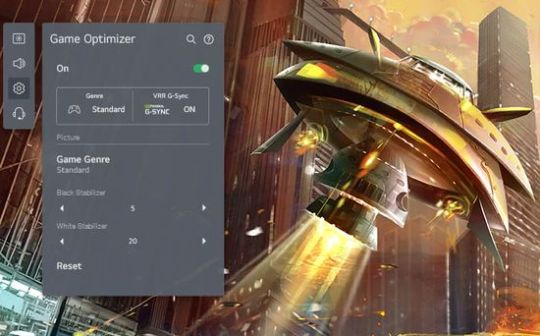
LG Game Optimiser
Conclusion
Pros
- excellent image quality;
- α9 Gen 4 AI Processor 4K with AI Picture Pro/Sound Pro;
- Dolby Vision IQ and Dolby Atmos;
- new fantastic webOS 6.0 + ThinQ AI w/ Magic Remote;
- gaming with G-SYNC, FreeSync, VRR and ALLM;
- beautiful 4K/HDR picture;
- four HDMI 2.1 ports;
- amazing upscaling.
Cons
- glare due to the reflective glass surface in daylight;
- no HDR10+.
As known, LG fundamentally ignores HDR10+ standard, preferring to solve this problem using the Dynamic Tone Mapping mode.

LG Dynamic Tone Mapping
The LG C1 OLED TV is quite realistically claiming to be this year's bestseller among OLED TVs. At $ 2,500 for the 65-in model, it fits harmoniously between the LG A1 (non-gaming, webOS 6.0, priced at $ 2,200 / 65 inches) or last year's great CX (webOS 5.0, α9 Gen 3 AI Processor 4K, priced at $ 2,200 / 65 inches) and the flagship LG G1 (bright innovative Evo panel up to 1,000 nits, $ 3,000 / 65 inches).
Paradoxically, LG C1 TV can compete with the new LG QNED 4K TVs. Quantum Dot technology ( LG's NanoCell) and innovative miniLED backlight significantly improved the image quality of LCD models, raising it almost to the level of OLED technology. At about $ 2,000 for the 65-inch model, new LG QNED TVs will be quite competitive compared to the LG C1, given the identical processors, AI algorithms, webOS 6.0, AI Picture Pro / Sound Pro technologies, etc. But, of course, a correct assessment is possible only after they appear on sale.
The video demonstrates the differences in brightness between LG's OLED and QNED TVs.
Read the full article
#AIPicturePro/SoundProtechnologies#ALLM(AutoLowLatencyMode)#AutoVolumeLevelingfeature#DynamicToneMappingmode#EARC#FineTuneDarkAreasfeature#GameOptimiser#LGA1OLEDTV#LGC1OLEDTVs2021#LGCXOLED(2020)TV#LGG1OLEDTV#LGOLED65C1PUBTV#MagicExplorer#MagicTapmode#miniLEDbacklight#NextPickfunction#SportsAlert#webOS6.0#α9Gen4AIProcessor4K
0 notes
Text
LG G1 Gallery Series OLED TV is the best in 2021? Review
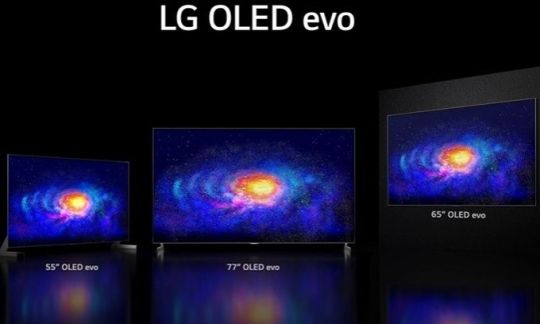
Almost 10 years ago, the advancement of display technology in TVs split into two directions. LG and SONY focused their efforts on the development of OLED TVs that provide excellent picture quality through virtually unlimited contrast due to the lack of LED backlight.
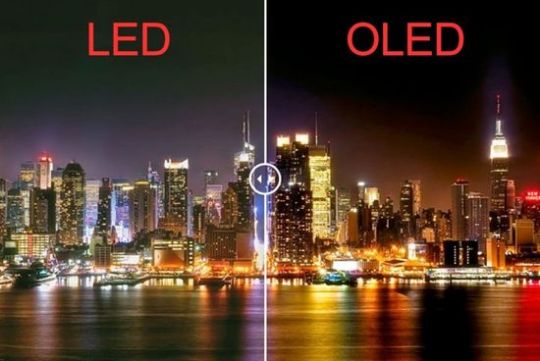
OLED vs LED LCD TVs
Unfortunately, this technology is significantly more expensive and limited in brightness. In addition, increasing the OLED panel size dramatically increases its price.
Samsung has taken a different path, focusing its efforts on developing Micro LED technology. It also based self-emitting LEDs and does not require backlight, but uses microLED modules that solves the problem of panel size.

Samsung Micro LED modul
This technology provides amazing quality, but today it's insanely expensive. For example, Samsung unveiled a 109-inch Micro LED panel at CES 2021 at a cost of $ 156,000.

Samsung MicroLED 2021
Other leaders have continued to improve on traditional and cheaper LED LCD TVs.
QD technology & miniLED backlight
Quantum Dot technology marks the first breakthrough in this direction. Samsung have found a neat solution to radically improve the white quality for backlight. Simplified, it uses a special film with nanoparticles, the size of which corresponds to the wavelength of red and green. Behind the film is illuminated with blue LEDs. Nanoparticles on the film surface partially absorb blue and emit red and green, depending on their size. Then blue, red and green are mixed into white, which is closer to natural white.
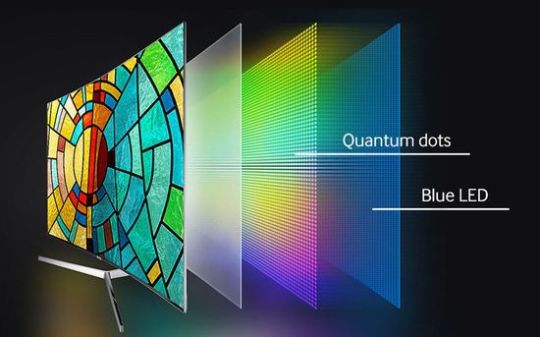
Samsung quantum dot technology
In fact, Samsung has created an analogue of the little sun in TV. This solution has greatly expanded the color accuracy and color gamut.
Subsequently, other companies developed their own similar technologies under different names, including Sony Triluminos, LG NanoCell, and Hisense ULED.
Chinese giant TCL has begun the second phase of revolutionary LCD TVs improvement by developing a new backlight technology based on the use of miniature LEDs. The tiny size allowed the developers to increase the number of LEDs to tens of thousands, and group them into thousands of local dimming zones with independent control.
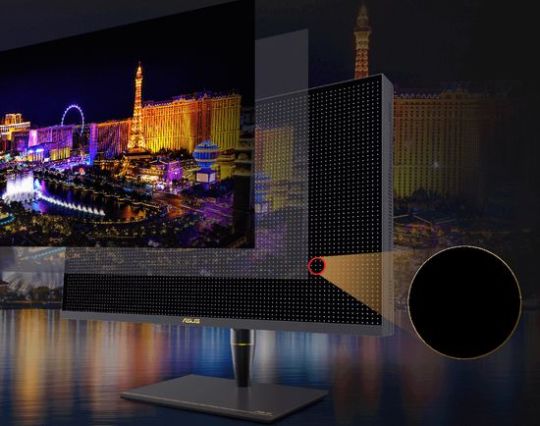
Mini-LED technology
This technology provides brightness control in different areas of the frame. As a result, it improves overall image contrast and HDR performance.
TCL has developed several generations of miniLED backlight, including:
- 2018 - TCL 6-Series Roku TV with Contrast Control Zones technology;
- 2019 - TCL 8-Series Roku TV with improved mini LED Quantum Contrast technology (over 1,000 Local Dimming zones);
- 2020 - Vidrian mini LED technology.
- 2021 - C825 with OD-Zero (Optical Depth Zero) mini LED technology.
At CES 2021 Samsung and LG unveiled their own Neo QLED and QNED TVs with similar technology.
LG G1 (OLED65G1) Gallery Series OLED TV
But today, OLED TVs continue to confidently dominate in terms of picture quality. The latest LG G1 OLED TV can rightfully be positioned as one of the best TVs of 2021.
Pros
- traditionally excellent contrast;
- more high brightness with innovative Evo technology;
- high accurate color;
- 4 HDMI 2.1 inputs and excellent gaming features;
- impressively thin design;
- new webOS 6.0.
Cons
- $ 500 more expensive compared to the great LG OLED C1 (OLED panel is not Evo);
- no stand included;
- some picture settings options are too complex.
The G1 comes without a stand but has an adjustable wall mount.

LG OLED G1 wall mount
Additionally, the company sells a versatile two-legged stand for tabletop installation for $ 100.
Ultra thin profile and virtually bezel-less design provide maximum similarity to the painting on the wall.
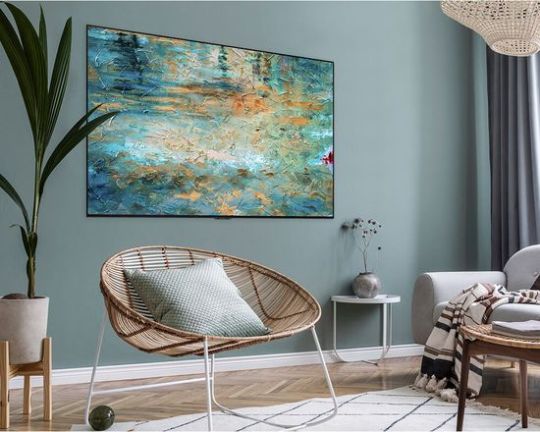
LG OLED G1 Gallery Series
Moreover, the company promises a metallic tripod-style stand. Of course, this three-legged floor stand will radically simplify the TV location.
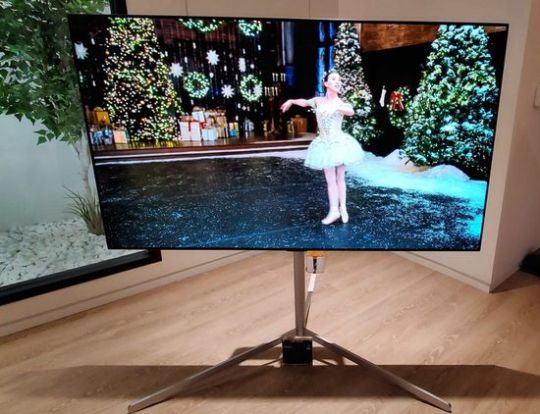
LG OLED G1 three-legged floor stand
Unfortunately, its price is still unknown.
OLED Evo technology
Of course, OLED Evo technology is one of the major improvements of the new G1 lineup. As known, relatively low brightness is one of the main cons of OLED panels. Evo technology increases peak brightness by about 20% or up to of 1,000 nits (cd / m2).
In fact, OLED pixels are a stack of multiple layers. Traditional LG WRGB OLED displays use a dual substrate with blue emitters and internal substrates with organic red and yellow-green emitters. But blue OLED emitters have relatively low efficiency and a shorter lifespan. A double substrate with blue emitters compensates for these cons.
Evo OLED panels use an additional third green emitter layer between two blue emitters.
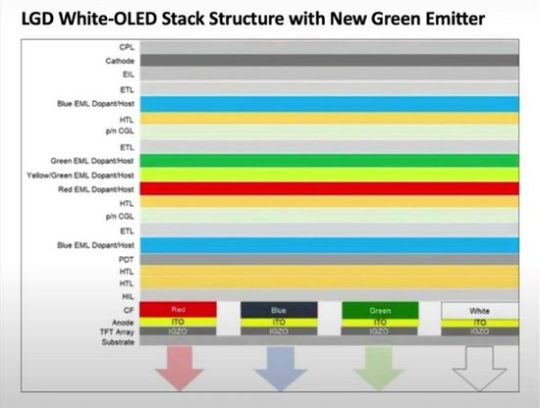
LGD White-OLED Stack Structure with New Green Emitter
Combined with red and yellow-green, this structure increases the panel brightness and extends its color gamut.
In addition, the blue emitters of the new panels are made from new materials. According to UBI Research CEO Choong Hoon Yi, LG Display has changed its supplier from Idemitsu Kosan to DuPont, which has long specialized in the development of inkjet OLEDs.
The DuPont's blue emitters use deuterium instead of hydrogen, which is significantly more efficient. As known, increasing the panel brightness requires increasing the current. But this is accompanied by heating, accelerating the OLED panel degradation. For example, Panasonic's bright premium OLED models use a complex and expensive heat dissipation system. As a result, the improved efficiency of blue emitters has allowed OLED TV panel makers to increase the current and, as a result, panel brightness at the same lifespan.
According to preliminary information, Sony A90J and Panasonic JZ2000 TVs may also receive new Evo panels by the end of the year. But today they are only used in the LG OLED G1.
Picture settings, AI Picture Pro & AI Sound Pro
Reference standard SDR is ideal for evening viewing without bright daylight. The High in “Peak Brightness” setting is better for daytime viewing in fairly bright daylight.
HDR settings offer Cinema Home and Cinema User modes. By default, the color temperature is set to at warm 50. But changing it improves the image only in some dark scenes.
New algorithms and the powerful LG α9 Gen4 processor effectively smooth gradients and significantly reduce macro-blocking even of highly compressed cable / satellite TV content with low resolution. Moreover, the growth in the content quality is accompanied by a significant improvement in visual perception. 4K HDR content on 4K Blu-ray is played with rich and bright colors, ideal black has solid shadow detail.
Of course, the flagship is equipped with LG's AI Picture Pro & AI Sound Pro features. As known, AI Picture Pro detects the content type and automatically switches to the optimal picture mode.

LG AI Picture Pro
In addition, it optimizes the video processing depending on the scene type. For example, dark scenes require an increase in shadow detail. But the visualization of its effect is mainly manifested in heavily compressed content, for examle, from YouTube.
In fact, AI Sound Pro raises the audio level to a 5.1.2 Atmos signal for any connected device, including a soundbar or receiver.

LG AI Sound Pro
Despite its ultra-thin panel, the G1 really delivers very dynamic sound with acceptable bass. In addition, the built-in AI acoustic sound tuning can add bass. Of course, the virtual surround effects can be annoying for some viewers, but this aspect depends on individual preference.
WebOS 6.0 and Game mode
Of course, the new webOS 6.0 has significantly expanded the smart options of the new LD TVs.
Main differences:
- new interface.
The interface of the new version takes up the whole screen.

LG webOS 6 interface
- enhanced LG ThinQ AI function;
- Next Pick function;
- Magic Link function expanded to Magic Explorer.
The enhanced LG ThinQ AI option supports more voice input with Amazon Alexa and Google Assistant. Next Pick function greatly simplifies the search apps and content. Magic Explorer provides additional information about current movies and TV shows (information about locations, actors, etc).
LG G1 is ideal for games. In addition to support for up to 4K@120Hz, VRR (Variable Refresh Rate), Nvidea G-Sync, and AMD FreeSync through HDMI 2.1 ports, LG G1 offers a new Game Optimizer on-screen display for gaming settings.
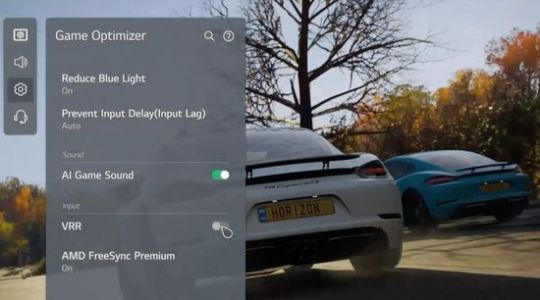
LG Game Optimizer on-screen display
Its interface contains picture settings to optimize different game genres. For example, First Person Shooter provides high visibility into dark areas. The Picture / Motion settings section is for control over motion smoothing, and for adjustment in light and dark areas. A separate interface panel provides direct access to VRR, G-Sync, and FreeSync switches.
Conclusion
In ascending order of price and quality, the market today offers:
- LED LCD TVs;
- LED LCD TVs with Quantum Dot technology (Samsung QLED, Sony Triluminos, LG NanoCell, Hisense ULED);
- new LED LCD TVs with QD technology and miniLED backlight, including Samsung Neo QLED, TCL OD-Zero, and LG NanoCell QNED;
- OLED TVs;
- insanely expensive Micro LED panels.
In the past few years, projector manufacturers have suddenly jumped into competition in this segment. They have developed a new generation of bright laser living room UST models. At a cost of several thousand dollars, they provide 100-120-inch high-quality 4K images and can successfully replace traditional TVs. Today such a solution is exotic for many, but the trend is rapidly gaining momentum. Their list includes:
- Epson EpiqVision laser projectors - $ 1,000 to $ 4,000;
- Optoma CinemaX 4K living room laser DLP projector - $ 3,300;
- VAVA VA-LT002 4K UST laser living room projector - $ 2,800.
But in terms of picture quality, OLED TVs continue to dominate, with the exception of the unprecedentedly expensive microLED panels. Today LG G1 OLED TV quite rightly claims to be the leader, providing high brightness with innovative Evo technology and amazing quality with vivid and rich colors. New webOS 6.0, Game Optimizer, four HDMI 2.1, AI Picture Pro & AI Sound Pro features complement the list of its pros.
As of April 24, the model is not yet available, but its price on the company's website is $ 2.999 for the 65-inch model.
This video shows a demo of the LG OLED G1 at CES 2021.
Read the full article
#Evotechnology#GameOptimizer#LGAIPicturePro&AISoundPro#LGG1GallerySeriesOLEDTV#LGNanoCellQNED#LGOLED65G1#LGα9Gen4processor#MagicExplorer#miniLEDbacklight#NextPickfunction#SamsungNeoQLED#TCLOD-Zero#webOS6.0
0 notes
Text
LG QNED MiniLED TVs 2021 Review

The miniLED backlight in LCD TVs has become the dominant innovation this year. At CES 2021, major industry leaders including Samsung, LG and TCL have unveiled the Neo QLED, QNED and OD-Zero series powered by miniLED backlight technology.
As known, it's based on the use of miniature LEDs. The tiny size allowed developers to radically increase their number to tens of thousands.
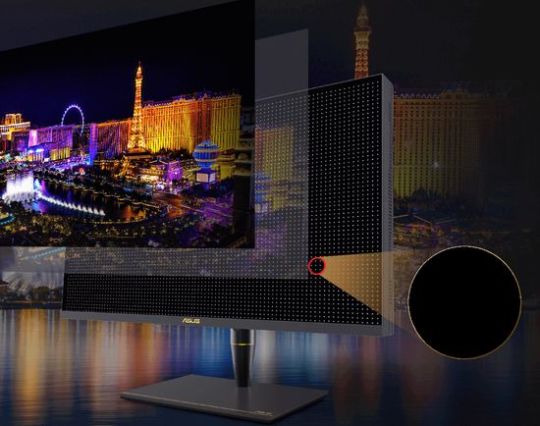
Mini-LED technology
Further, they are combined into arrays with separate control, forming 1,000 or more local dimming zones. In turn, an increase in their number provides accurate brightness control in different screen areas. In fact, miniLED backlight allowed developers to increase the black depth by decreasing the brightness in the certain screen areas. At the same time, TV retains the required brightness of other frame areas, increasing the overall image contrast.
As a result, miniLED backlight increases HDR performance, and provides better contrast control. This technology further reduces the difference in HDR content picture quality between expensive OLED TVs and much cheaper LED LCD models.
Therefore, the consumer market and experts were eagerly awaiting the market launch of LED LCD TVs with Quantum Dot technology (improving the white quality in the backlight) and with Mini LED backlight (increasing contrast due to increasing the number of local dimming zones).
LG miniLED TVs
The QNED lineup includes the 8K QNED99 / QNED95 and 4K QNED90 / QNED85 series.

LG QNED MiniLED TVs 2021
Each series offers 65, 75, 86 - inches models. In fact, the processor is one of the main differences between the series. 4K TVs uses α7 Gen4 4K, 8K models are equipped with α9 Gen4 8K. In America they will be sold under the name QNED90UPA, in Europe - QNED909PB. These series should go on sale soon.
Traditionally, the price will significantly depend on the region. Preliminary, the QNED90 series will occupy a price niche between LG NanoCell and LG OLED, and will be slightly cheaper compared to Samsung counterparts. Samsung is currently offering 4K Neo QLED TVs (Quantum Dot technology + miniLED backlight) for $ 2,200 / $ 2,600 for the 65-inch QN85A (QN55QN85AAFXZA) / QN90A (QN55QN90AAFXZA). These series differ in the matrix type. In particular, QN90A has VA panel with very high contrast ratio to display deeper blacks, QN85A uses ADS panel with wider viewing angles.
Prices for the 65-inch LG's OLED TVs 2021 range from $ 2,200 (A1 series) to $ 3,000 (G1 series).
LG NanoCell 4K 2021 list includes Nano 75, 80 and 90 series. The 65-inch LG 65NANO90UNA costs at $ 1,200.
Considering these factors, the price of the new 65-inch LG QNED 4K TV is likely to be slightly over $ 2,000. But,of course, the company's pricing strategy can make significant adjustments to these forecasts.
HDMI 2.1
QNED TVs use HDMI 2.1 (High Definition Multimedia Interface) interface, which increases bandwidth up to 48Gbps vs 18Gbps for HDMI 2.0. This allows the TV to display higher resolution images. In particular, models supports 4K@120Hz. In addition, HDMI 2.1 supports the Variable Refresh Rate feature, which is analogous to the popular AMD FreeSync and Nvidia G-Sync sync technologies.
What's more, Dynamic HDR supports the HDR mode on a frame-by-frame basis, further enhancing image quality.
HDMI 2.1 also supports Auto Low Latency Mode (ALLM) technology, which automatically determines the optimal latency for smooth playback.
In addition, HDMI 2.1 supports HDMI eARC for lossless audio streaming via the HDMI eARC port.
But LG QNED TVs are also backward compatible with the peripherals of the previous version of the 2.0 standard and use traditional connectors.
Of course, connecting external HDMI 2.1 devices requires an Ultra High Speed HDMI cable.

Ultra High Speed HDMI cable
HDR formats
In addition to HDR10, Dolby Vision and HLG, QNED TVs also support Dolby Vision IQ, which automatically optimizes the image based on ambient light sensors. In addition, Dolby Vision IQ recognizes the content type by automatically changing the settings.
Also, QNED90 supports the AV1 open video compression standard (codec), which is used to encode video transmitted over the Internet. Unlike the previous VP9, the AV1 can stream dynamic HDR metadata for Dolby Vision, HDR10+, etc.
As known, LG continues to ignore the HDR10+ standard, preferring to solve this problem using the Dynamic Tone Mapping mode. In fact, this technology was developed to improve HDR display on OLED screens and can be positioned as a competitor to HDR Dolby Vision. As known, low brightness is one of the main cons of OLED technology. The Dynamic Tone Mapping function automatically adjusts the brightness and contrast for content, whose parameters exceed the limits of the screen's capabilities.

LG Dynamic Tone Mapping
In fact, it adds dynamic metadata to optimize image contrast. At the same time, the Enhanced Dynamic Tone Mapping algorithm provides frame-by-frame video processing of HDR content.
Video processing and audio
QNED TVs support 10-bit color depth. As known, it directly affects the number of displayed shades and, as a consequence, the image quality.

10-bit color depth
The traditional 8-bit matrix provides 256 shades for each of the three RGB colors (red, green, blue). Accordingly, the cube number is 16.8 million shades. In comparison, a 10-bit matrix can display 1.07 billion shades per pixel. Usually, companies use 10-bit matrix only in premium models.
The QNED TVs support a 120Hz refresh rate.
QNED TVs use the upgraded LG α7 / α9 Gen4 4K / 8K processors with improved color and motion processing algorithms.

LG Alpha9 Gen 4
It adjusts object clarity and motion handling depending scene type. In addition, TVs support building recognition, scenery or night scene adjustments, and provide more efficient handling of smooth gradients. Additionally, the new chips provide auto-volume leveling in various apps.
The 2021 LG miniLED TVs also support the popular Filmmaker Mode, which disables certain picture optimization algorithms for the most realistic movie viewing. In this mode, the movie is played in its original color, frame rate and aspect ratio.
Since 2017, premium LG TVs have supported surround sound in Dolby Atmos format via built-in or external speakers. The 40W speaker system uses a 2.2 configuration.
Wireless Sound Sync function enables the broadcast of audio content from phones. Moreover, the TVs support the innovative WiSA technology for wireless transmission of multi-channel audio. They can stream sound from TV to compatible WiSA speakers (Klipsch, Bang & Olufsen, Axiim, Enclave Audio, etc). Moreover, in addition to the standard 5.1 configuration, this technology supports Dolby Atmos. Additionally, Summit function supports up to 8 channels of uncompressed audio. According to WiSA, the audio quality is about 20 times better than Bluetooh and Wi-Fi technologies.
WebOS 6.0 and Game mode
Since 2021, LG has been using webOS 6.0 instead of webOS 5.0, and a new Magic Remote with additional commands.
The list of main differences includes:
- new interface;
- enhanced LG ThinQ AI function;
- Next Pick function;
- Magic Link function expanded to Magic Explorer;
- new Magic Remote AN-MR21GA.
The new desktop is focused on personalized recommendations. The enhanced LG ThinQ AI option supports more voice input with Amazon Alexa and Google Assistant.
The new menu has simplified search apps and content using the Next Pick function. Magic Explorer provides additional information about current movies and TV shows (information about locations, actors, etc).
The new Magic Remote has new dedicated app buttons for Netflix, Amazon Prime Video, Disney Plus and LG Channels.
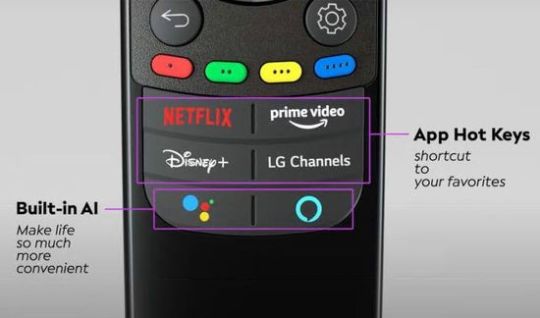
LG Magic Remote AN MR21GA
An NFC button for communicating with a smartphone is also located on the remote. But, of course, the smartphone must support NFC technology.
Unfortunately, the company hasn't stopped advertising on the new platform.
For gaming, TVs support HGiG (HDR Gaming Interest Group) mode. As known, it was developed by Microsoft and Sony to improve visuals in games. In fact, HGiG recognizes the TV's performance and picture quality, and then adjusts the HDR graphics.
ALLM & eARC meet the latest HDMI 2.1 specs, providing playback of fast-moving content in higher resolution and synchronized graphics.

LG QNED game mode
The new Game Optimizer tweak groups key gaming parameters, including frame rate and latency. In addition, the TVs offer multiple presets for any game genre or manual customization.
According to the company, in the second half of 2021, the QNED TVs will support Google's Stadia gaming streaming service, which offers 4K HDR @ 60fps gaming with 5.1 channel surround sound.
Conclusion
Presented at CES 2021 LG QNED TVs with innovative mini LED backlight quite realistically claim to be this year's bestsellers. They support Dolby Vision, HDR10, HLG, Advanced HDR, HDMI 2.1, Dolby Atmos and use the new webOS 6.0. In addition, these models are equipped with almost all innovative technologies in the industry.
But, of course, the competition will not be very easy for the South Korean company. QNED TVs will compete with TVs from another South Korean giant. Samsung already sells
Neo QLED TVs with mini LED backlight. Moreover, the Chinese giant TCL already presented its flagship X12 8K TV with OD-Zero mini LED backlight. Thus, during this year, the market should be replenished with new generation LCD TVs with Quantum Dot technology and with miniLED backlight from three industry leaders. Probably, already this year side-by-side comparison Samsung Neo QLED vs LG QNED vs TCL OD-Zero will showcase their pros & cons. But, in any case, the new technology promises to reduce to a minimum the difference between OLED models and LCD + Quantum Dot technology + mini LED backlight TVs.
This video showcases LG's 4K and 8K QNED miniLED TVs at CES 2021.
Read the full article
#ALLM&eARC#ALLMtechnology#AutoLowLatencyModetechnology#DolbyVisionIQ#DynamicToneMappingfunction#FilmmakerMode#GameOptimizer#HDMI2.1#HDRGamingInterestGroup#HGiG#LGQNEDMiniLED65QNED90#LGQNEDMiniLED75QNED90#LGQNEDMiniLED86QNED90#LGQNEDMiniLEDTVs#LGQNED909PB#LGQNED90UPA#MagicExplorerfunction#MagicRemoteAN-MR21G#NextPickfunction#QuantumDottechnology#SamsungNeoQLEDTVs#TCLOD-ZerominiLEDbacklight#TCLX12OD-ZerominiLED8KTV#VariableRefreshRatefeature#webOS6.0#WirelessSoundSyncfunction#WiSAtechnology
0 notes
Text
Newest Samsung Neo QLED Mini LED TVs Review
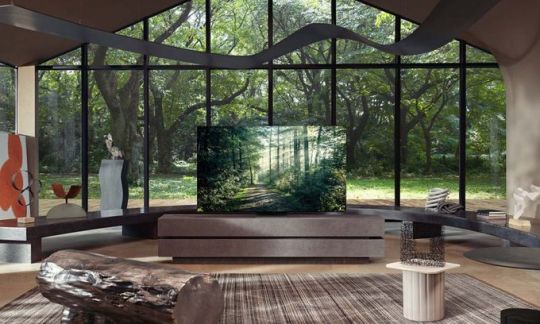
Innovative Samsung Neo QLED TVs are already available. As known, LCD mini LED TVs became the main trend at CES 2021. In particular, Samsung, LG and TCL announced TVs with super-innovative mini LED backlight technology under the names Neo QLED, NanoCell QNED, and OD-Zero, respectively.
They use 1000 or more local dimming zones due to the use of a huge number of miniature LEDs, which are combined into arrays with separate control.

mini LED backlight technology
As a consequence, a radical increase in their number significantly increases the contrast due to more accurate brightness control in different areas of the frame. In fact, this technology dramatically improves black levels, enhancing the overall image contrast. Thus, the mini LED backlight reduces the difference in HDR content picture quality between expensive OLED TVs and much cheaper LED LCD models.

OLED vs mini-LED
Neo QLED TVs price (with free Prime shipping):
Neo QLED 4K QN90A Series (QN55QN90AAFXZA, 2021 model)
- 55-inch - $ 1,800;
- 65-inch - $ 2,600;
- 75-inch - $ 3,500;
- 85-inch - $ 5,000.
QN85A Series (QN55QN85AAFXZA, 2021 model)
- 55-inch - $ 1,600;
- 65-inch - $ 2,200;
- 75-inch - $ 3,000;
- 85-inch - $ 4,500.
The QN90A and QN85A use different panels. QN90A has VA panel with very high contrast ratio to display deeper blacks, QN85A uses ADS panel with wider viewing angles. As known, ADS (Advanced Super Dimension Switch) panel is an improved version of the popular IPS matrix.
Samsung QN90A
The Samsung QN90A is the flagship 4K smart TV with innovative mini LED backlight in Samsung's 2021 lineup. In fact, this series replaces the Samsung Q90 / Q90T QLED. The QN90A has NeoSlim design with ultra-thin frame.
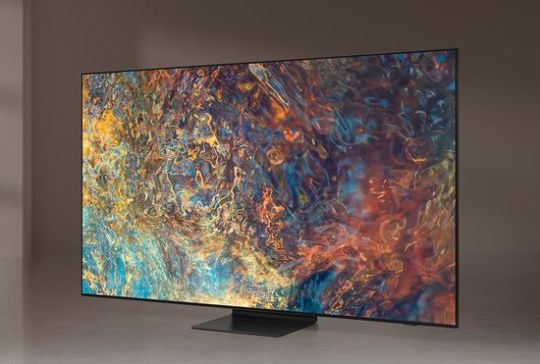
Samsung Neo QLED 4K QN90A design
The use of miniature LEDs allowed the developers to reduce the thickness of the TV by 1 cm. Their height is about 40 times smaller than a conventional LED.
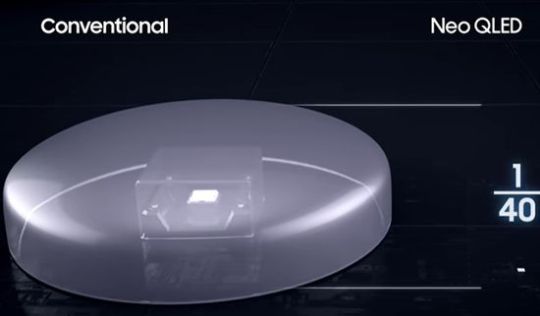
LED in Leo QLED
As a result, max TV thickness does not exceed 1.06" (2.7 cm). The shape of the remote control has not changed, but it can now use a solar panel.
Of course, unlike self-emitting OLED or MicroLED technologies, mini LED backlight do not provide pixel-level control. But the QN90A already uses over 700 local dimming zones, delivering almost perfect black without distortion of dark gradations.
The new Neo Quantum 4K processor processes video using 16 different neural networks that enable intelligent upscaling based on deep learning.

Samsung Neo Quantum 4K processor
Really, TV easily upscales content with 480p (DVD), 720p (cable TV) and 1080p resolution up to native 4K with almost no upscaling noise added. But, it can't display an 8k signal.
Brightness, uniformity and viewing angle
The QN90A is much brighter vs Q90 / Q90T. For SDR, Dynamic Picture Mode with Standard Color Tone provides max brightest image (almost 1,790 cd / m² or nits in the 10% window). But, of course, these settings slightly reduce image accuracy.
The Mini LED full-array local dimming feature works great, delivering deep blacks even in the dark. But when viewing off-angle, the playback is accompanied by a little blooming around bright objects.
The maximum brightness for HDR content reaches 1,600 nits, and even up to 1,800 nits for small bright image peaks.
The anti-glare screen perfectly suppresses reflections. Its Total Reflections, Indirect Reflections, and Calculated Direct Reflections are only 1.7% (good value - 4.5%), 0.9% (good value -1.0%) and 0.8%, respectively.
Unfortunately, direct light sources can cause a dim effect in large areas of bright colors due to the aggressive Automatic Brightness Limiter (ABL).

Automatic Brightness Limiter (ABL)
The QN90A provides good gray uniformity, and excellent black uniformity with local dimming enabled.
The gray uniformity measurement demonstrates:
- 0.68% for 5% Std. Dev. (average squared difference of pixels when displaying a mid 5% gray) - good value
Read the full article
#MiniLEDfull-arraylocaldimming#Mini-LEDbacklight#NanoCellQNEDTV#NeoQLEDTV#OD-ZerominiLEDbacklight#QN55QN85AAFXZA#QN55QN90AAFXZA#SamsungNeoQLED4KQN85ATV#SamsungNeoQLED4KQN90ATV#SamsungNeoQLEDMiniLEDTVs#SamsungOTS+#SamsungQ90/Q90TTV#TCLX128KOD-ZeroTV#UltraViewingAngletechnology
0 notes
Text
DJI Mavic Mini vs DJI Mavic Mini 2 Review

As known, the portable foldable DJI Mavic Mini was announced at CES 2019 as the next generation of the super popular Spark selfie drone. Already in October 2019 this model was available on Amazon.
Predictably, unprecedentedly low weight (8.78 oz or 227 grams without battery), 12MP aerial photos, 2.7K HD video, 30 min Flight Time at a maximum speed Max Speed 13 m/s in S Mode (no wind), and FPV distance of up to 4 km provided the model with a huge popularity. In addition, the requirements of the FAA (Federal Aviation Administration) in the US do not apply to models weighing up to 250 grams, radically simplifying their use.

super lightweight DJI Mavic Mini drone
As a result, in 2020 most experts have positioned the DJI Mini as the best non-professional mini drone for aerial photos. But the company didn't stop there, unveiling the DJI Mavic Mini 2 in November 2020. It's no secret that marketing goals are often the reason for the development of updated gadgets, providing additional advertising for a popular model without fundamental changes to the specs. But the Mavic Mini 2 is really better and deservedly replaced Mavic Mini on Amazon's bestseller list.
DJI Mavic Mini 1 vs Mini 2
Design and weight have not changed.

DJI Mavic Mini vs DJI Mavic Mini 2 Design
The list of external differences includes the Mini 2 lettering, an additional LED on the front, Type-C instead of microUSB, and a different shape of the motors. But DJI Mini 2 is lighter by 10 grams and faster (16 kph vs 13 kph), has additional Trimmed Download and QuickTransfer features for video editing and downloading, uses OcuSync 2.0 and the upgraded 4K camera.
The new motors are lighter, quieter and cooler due to more efficient cooling.

DJI Mavic Mini 2 vs Mini motors
They increased the max speed to 35,79 mph vs 29,08 mph.
Of course, the Mini 2 is more expensive. As known, the company offers Standard and Fly More Combo drone versions. The basic model includes a drone, a remote (type-c, microUSB, Lightning connection), charging and remote cables (USB-A / Type-C), one pair of spare propellers, a screwdriver and one battery (flight time up to 31 minutes). Fly More Combo additionally includes:
- two intelligent flight battery (total flight time more than 1.5 hours);
- two pair of spare propellers and 12 spare screw;
- propeller holder;
- two-way charging hub (charge up to three batteries in sequence, but do not work with DJI Mavic Mini);
- DJI 18W USB Charger;
- shoulder bag.
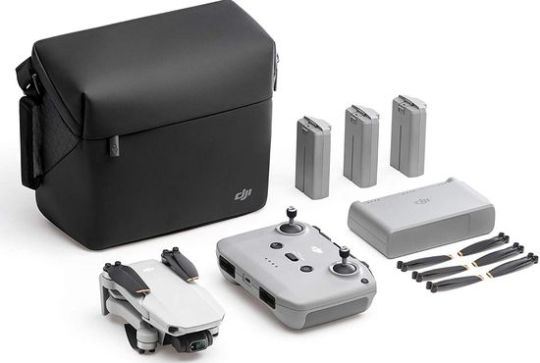
DJI Mavic Mini 2 Combo
Their total price is almost $ 190. In fact, the Combo version saves around $ 40.
Today, the company sells the base model for $ 450, and the Fly More Combo for $ 600. By comparison, the Mavic Mini costs only $ 380 / $ 500, respectively. Maybe the difference under $ 100 seems insignificant, but it's more than 25%.
New remote controller
Of course, the new remote with OcuSync 2.0 is one of the major pros. This technology was developed and patented for the Phantom series. In fact, it's a very powerful radio transmitter that works on Wi-Fi frequencies to provide a more stable signal. The new drone uses OcuSync 2.0 version. Unlike the first generation, OcuSync 2.0 dynamically changes the signal frequency in the range from 2.5 to 5.8 GHz, automatically choosing the less loaded bandwidth. As a result, the amount of interference is reduced, increasing the stability of communication between devices. Testing demonstrates the complete absence of interruptions and loss of communication in the city at a distance of up to 400 meters, even without tuning the antennas and an additional amplifier. At the same time, the image is radically clearer. In the Mini 2, OcuSync 2.0 provides 10km HD video transmission.
In addition, it's compatible with Mavic Air 2 and has an oversized holder for a 6.7-inch smartphone in a case.
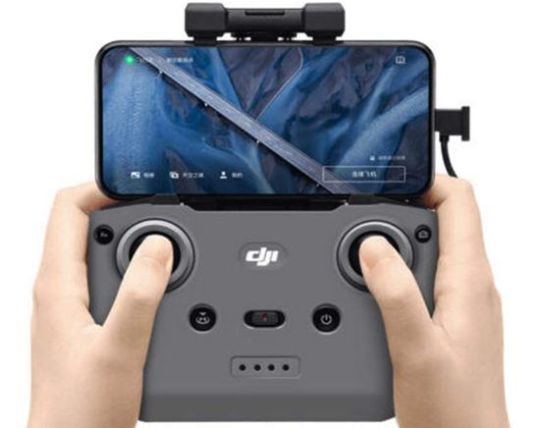
dji mini 2 remote
The cable for its connection is very conveniently placed under the clamp. Moreover, the company has increased the size of the buttons for turning the drone on and back. The Cinema / Normal / Sport flight mode selection button is also large and comfortable.
Additionally, the developers have changed the functionality of the shooting buttons. Now one button switches photo / video mode, the other activates it.
Shooting modes and image quality
In addition to Dronie, Helix, Rocket, and Circle QuickShot modes in Mini 1, the new model supports Boomerang Mode.
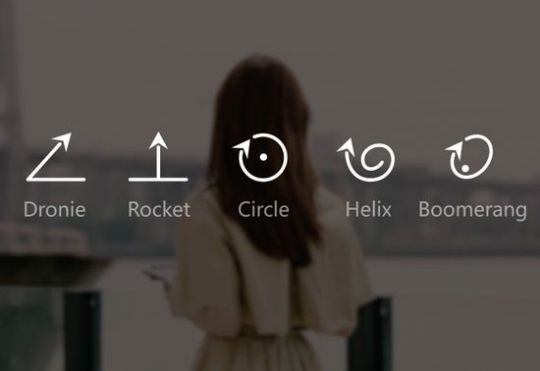
DJI Mini 2 QuickShot modes
Moreover, Mini 2 supports 4K Hyperlapse (shooting with a given interval) and Panorama modes. This mode provides instant photo download to the phone.

DJI Mavic Mini Panorama mode
Advanced gimbal stabilization and 4k camera significantly increased the smoothness and image quality. The model supports video to 4K@30 fps, 2.7K@60 fps, and FHD@60 fps with max video bitrate up to 100 Mbps. Mini 1 with 2,7K@30 fps and FHD@60 fps provides bitrate of up to 40 Mbps.
In addition, The Dji Mini 2 has Digital 2x / 3x / 4x zoom range for 4K / 2.7K / FHD resolution, respectively.
Unfortunately, drone does not have a popular tracking mode.
Of course, the RAW format support (full raw data without loss of information) in the photo mode is also a significant progress of the model.
ISO range of its camera is 100-3200 (auto & manual) for video and photo. Mini 1 also provides 100-3200 (auto & manual) for video, but 100-3200 (manual) and only 100-1600 (auto) for foto.
As known, an increase in ISO reduces the image contrast due to digital noise that increases its graininess.

image quality and iso sensitivity
On the other hand, shooting in low ambient light requires high ISO. ISO range of Mini 2 camera is consistent with these requirements. But, of course, it's not ideal for shooting in the evening.
Camera extract is from 1/8000 to 4 s.
Conclusion
The Mini 2 retains the traditional cons of any mini drone. Of course, the lack of sensors reduces weight, but significantly increasing the risk of the drone colliding with obstacles. Moreover, the low weight cannot ensure the flight stability at the wind. But model is relatively cheap, ultra-compact and does not require registration in America, due to its weight less than 250 grams.
Compared to the Mini 1, the company has improved motors, quality and range of communication, camera, and expanded shooting modes.
Mini 2 with new motors can resist level 5 winds (up to 11 m / s) and fly at max altitude of 4,000 meters with max speed of up to 35.79 mph. In addition, OcuSync 2.0 significantly improved the quality and range of communication. The new camera captures videos up to 4K@30fps and supports RAW format. Moreover, the new drone supports 4K Hyperlapse and Panorama features, and an additional Boomerang QuickShot mode. Taking these factors into account, the difference of $ 70- $ 100 is more than justified.
Today Mini 2 has practically no competitors in the segment of mini drones weighing less than 250 grams. But without considering the registration factor, the specs Mini 2 are significantly inferior to the DJI Mavic Air 2, with a price of $ 800 and a weight of 20.1 oz or 567 g. The choice between Mini 2 and excellent SJRC F11 4K Pro, which costs only $ 360, but weighs 18.34 oz or 520 g is also controversial.
But considering the registration, the DJI Mavic Mini 2 is out of competition today.
This video introduces the DJI Mini 2.
Read the full article
#DJIMavicAir2#DJIMavicMini2Dron#DJIMavicMiniDron#DJIMavicMinivsDJIMavicMini2#FlyMoreCombo#OcuSync2.0#QuickShotmodes#SJRCF114KPro
0 notes
Text
VAVA VA-LT002 4K UST laser living room projector Review

The VAVA brand is owned by a subsidiary of the Chinese Sunvalley Group, which was founded on 18 May 2007 under the name Sunvalleytek International Inc in San Jose, California. Today it's headquartered in Shenzhen, China. Sunvalley Group has subsidiaries in San Francisco, Tokyo, Singapore, and Hamburg, which own six consumer electronics brands, including VAVA, RAVPower, HooToo, Sable, TaoTronics, and Anjou.
The list of VAVA products includes Home Cameras and Dash Cameras, baby thermometers, headphones, etc. VAVA UST laser 4K projector has become a new and very successful business line. The developers managed to create a model with an excellent price / quality ratio. Already several years VAVA 4K successfully competes with living room laser projectors from Optoma, Epson, Sony, Hisense, ViewSonic and LG.
Living room projectors
But its success is also due to a very accurate commercial forecast. Over the past few years, the popularity of UST laser streaming projectors for the living room has grown rapidly. Huge progress in development of the laser light sources and screen mirroring technologies have practically solved the problem of brightness and content. In turn, this factor has radically expanded the capabilities of projectors as a replacement for traditional TVs.
Of course, its placement in the living room was a problem. Traditional Home Theater projectors usually have a ceiling mount. In addition, in the Home Theater room a projector can be placed on a coffee table in the center. But in the living room, such a solution is not always convenient due to the complex installation on the ceiling or wires on the floor.
Companies have successfully solved this problem by developing the UST (Ultra Short Throw) projectors. Their difficult and expensive optics with Throw Ratio less than 1 (0.20: 1- 0.8: 1) projects diagonal image from 100" at a Throw Distance of just over 10".

UST projector
But due to the steep angle of projection, the light partially is reflected upwards. Therefore, its effective reflection towards the viewing area requires a special UST ALR (Ambient Light Rejecting) screen.

UST ALR Screen
Unfortunately, they cost about $ 1,000 for a 100-inch screen. Significantly cheaper ALR screen also quite successfully solves this problem, but with a partial loss of luminous flux. Of course, this factor should be considered when choosing a projector. In particular, a large margin of brightness will help maintain high image quality in a living room with diffused daylight, even on a conventional ALR screen.
Main specs
As known, in mid-April 2020, VAVA updated firmware for VA-LT002 to Version 1.64. The new version has eliminated image quality issues for SDR and HDR videos, added 3D mode, etc.
This model is compatible with HDR10 high dynamic range content, but does not support HLG.
It generates colors using a 0.47-inch DLP XPR imaging chip, a blue-laser source, and a phosphor wheel.
VAVA is available in white and black, support Ultra HD 4K (3840 x 2160) resolution and Full HD 3D, uses 10-bit Color Processing, provides 2,500 ANSI Lm brightness and 1,500,000: 1 dynamic contrast ratio (3,000: 1 full on / off - native contrast), and has a beautiful built-in Harman Kardon Sound Bar.
In addition, the projector provides a huge Image Size up to 150” with Throw Distance of 1.3 ft - 2.6 ft (0.4 m - 0.8 m) at Throw Ratio of 0.23: 1.

VAVA 4K Projector 150 Inch Display
But a 100" image requires only 7.2" distance between the projector front and the wall.

VAVA 4K 100 inces image size
Finally, the VAVA 4K has 2GB RAM, Horizontal & Vertical Digital Keystone correction, Frame Interpolation, HDR mode, Android OS and supports Streaming Apps. Its Input Lag is 98ms and 101ms (4K).
The projector also uses Intelligent Eye Protection with IR sensors. It immediately dim the laser to the lowest level in case of human detection. Of course, an adult is unlikely to look into the laser during its operation. But this precaution will clearly be useful for curious children and pets.
Despite the use of 3 fans for cooling, the audible noise of the projector does not exceed 32 dB, which is great for a bright model.
ALPD 3.0 laser engine
Projector uses well-respected Appotronics ALPD 3.0 laser engine, which is one of its main pros.

ALPD 3.0 technology
This technology is the most innovative today. As known, ALPD (Advanced Laser Phosphor Display) technology was developed in 2007 by Chinese high-tech Appotronics Corporation Ltd, which is one of the world leaders in the development of semiconductor light source. In particular, the company has more than 1,450 patents in the field of laser displays. In Aug 2018, the company released ALPD 4.0 version already.
The use of high-efficiency and cost-effective GaN (gallium nitride)-based blue lasers allowed the company to solve the problem of temperature instability for red laser materials, and the low efficiency and short life of green lasers. Moreover, the combining the high brightness with the high performance of fluorescence eliminated the visual speckle issue due to the coherence of laser light sources.
In fact, ALPD is based on the laser-excited fluorescent materials and mixed multi-color laser lines. It provides higher color accuracy and wider color gamut. According to the developers, ALPD increases light source efficiency by about 20%, compensating for the loss of light output at the color wheel of the single-chip DLP projectors. Finally, lower blue light energy and lower strobe frequency reduces eye fatigue.
Overall, ALPD 3.0, an improved three-segment color wheel, a enhanced NTSC range of 85%+, together with a red light projection rate improved by 60-80% provide high accuracy of color rendering.

VAVA 4K colors
In fact, the covered color gamut exceeds the Rec.709 color space, but smaller than the DCI-P3 gamut (~ 130% Rec. 709, 90% DCI-P3, and 60% Rec. 2020).
Additionally, ALPD extends laser life by about 25%.
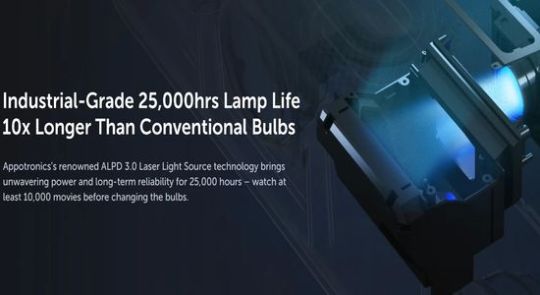
VAVA 4K Lamp Life
Settings
The projector has independent red, green, and blue gain controls to adjust color temperature that directly affect white and color accuracy.
Unfortunately, the cons list also exists and includes:
- full-screen picture adjustment menu does not allow to visually assess their effectiveness;
- Sound menu is only accessible from the Home menu. Probably, it's more convenient in the slide-out menu;
- motorized focus control uses only test pattern and requires exiting the live program;
- two-position Brightness control is always reset to Standard setting by default without storing the High setting. This is inconvenient for frequent daytime use of the projector in a living room in daylight. Moreover, the High level differs little from the Standard, which is set almost at max;
- the model does not store settings for different color modes.
This option is especially important for UST living room projectors, because the optimal settings for Contrast and Brightness differ significantly, for example, for dark-room SDR, bright-room SDR, and dark-room HDR viewing.
The VAVA only stores one tuned picture preset per HDMI input. Therefore, any adjustment is actually for all picture presets on all inputs. But today, most premium projectors provide independent settings for multiple presets on each input;
- no control for selecting overall gamma with SDR content and no HDR tone-map setting;
- no RGB Offset controls and color management system (CMS) to adjust the red, green, and blue color points.
Most likely, the company will eliminate them in the new firmware. But perhaps simplifying custom settings is a strategic choice of company. After all, a New York chef is hardly a specialist in calibrating complex electronics, and high-quality presets are much more convenient for him. Maybe in the future, companies will solve this problem, for example, through the remote calibration service.
Color Modes
The VAVA has a five color mode presets for each input, including Standard (the default), Movie, Colorful, Sports, Customized and PC for a computer. Each mode offers four Color Temperature settings, including Warm, Standard (the default), Cool, and Customized (access к RGB Gain controls). The adjustment of most parameters is available for each input only in the Customized mode.
Dark-room SDR
Color reproduction with the presets projector with previous firmware 1.42 version was far from ideal. But the new firmware has practically eliminated this problem.
Dark-room HDR
Calibrated SDR settings are great for dark-room HDR with a wide range of HDR10 content.
Bright-room SDR
The default PC mode with the Standard or Warm color temperature provides the best result. But in daylight, the image quality is much more dependent on the screen, lowering the value of the settings.
3D Viewing
New firmware contains 3D menu with selection of 3D type for 3D disc (Left Right, Top Bottom and Frame Encapsulation). Unfortunately, the projector does not automatically detect 3D content and does not offer dedicated 3D picture mode. In addition, the image is too dark even at maximum brightness in a dark room and has a red tint. But ghosting and parallax error are practically absent. In principle, this quality is unlikely to suit 3D fans, but it's quite acceptable for viewing.
3D mode requires DLP-Link glasses.
Kardon-branded Sound Bar & Aptoide platform
As an all-in-one entertainment center, VAVA 4K has a built-in Sound Bar and smart streaming platform.
Traditionally, the Harman Kardon-branded two-channel stereo system is premium.

VAVA 4K projector Harman Kardon Sound Bar
Each channel uses a 2.75-inch midrange and 1.5-inch dome tweeter (ABS + PC) in separate cases. Additionally, passive radiators optimize the bass. Instead of standard PCM digital audio, the projector uses Dolby Digital Plus and DTS-HD decoding on-board, which further enhances sound quality.
The 30 watts to each channel provide a total of 60 watts. The audio menu offers three settings.
When tested, the projector provided peaks of up to 90 dB from 10 ft in the Theater mode. This volume level is more than sufficient for most people in a medium-sized room. In addition, the system perfectly reproduces dialogues without distortion at any volume setting.
The VA-LT002 runs the Android OS, using the Aptoide smart TV platform for downloading of VAVA's streaming apps.
Unfortunately, Aptoide platform and its apps don't work very well with many services, including NBC, Amazon Prime Video, and Netflix Player. But adding an inexpensive Amazon Firestick, Roku, Google Chromecast or other 4K-compliant streaming player solves this problem easily. They support a wide range of compatible apps and have easy navigate.
Pros & Cons
Pros
- high image quality after adjustments;
- excellent on-board Harman Kardon sound system;
- very good value for money;
- 25,000 Lamp Life;
- ALPD 3.0 laser engine;
- 130% Rec. 709 color gamut;
- 150-inch Image Size;
- Intelligent Eye Protection.
Cons
- accurate color requires calibration;
- limited number of settings and not very convenient access to them;
- no adjustments for HDR mode and HDR brightness control;
- not always correct operation of Aptoide platform;
- Input Lag almost 100 ms;
- average quality of 3D content playback;
- possible focusing problem for 150-inch image.
A 150-inch image can have a focusing problem at the center and the four corners simultaneously, which is common with most UST projectors. Perhaps industry leaders deliberately limit their UST models to 130-inch picture for this reason. It's also scary to imagine the price of a 150-inch UST ALR screen, given the $ 2,000 of 120-inch screens.
Conclusion
The prospect of competition with recognized industry leaders did not embarrass the management of the young ambitious company - VAVA burst into a saturated market and succeeded.
Today VAVA 4K successfully competes with the popular Optoma CinemaX P2 4K laser projector, and with the great Epson EH LS300 UST model, from а new Epson EpiqVision series.
The CinemaX P2 is brighter (3,000 vs 2,500 ANSI Lm), has better dynamic contrast ratio (2,000,000: 1 vs 1,500,000: 1), lower Input Lag (67ms vs 98ms) and excellent out-of-box settings. But VAVA is cheaper ($ 2,800 vs $ 3,300), has a more powerful 60W Harman Kardon-branded stereo system and larger max image size (150" vs 120").
The Epson EH LS300 is significantly brighter (3,600 ANSI Lm CLO vs 2,500 ANSI Lm) and cheaper ($ 2,000 vs $ 2,800). But it is inferior in resolution (1080p vs 4K), projection size (120" vs 150") and audio system power (40W 2.1 speaker system by Yamaha vs 60W stereo system).
With these specs, the choice is unlikely to be easy.
The video offers an overview of the VAVA VA-LT002 4K UST laser projector.
Read the full article
#AdvancedLaserPhosphorDisplaytechnology#ALPD3.0laserengine#AmbientLightRejectingscreen#EpsonEpiqVisionEHLS300USTprojector#OptomaCinemaXP24KUSTlaserprojector#USTALRscreen#VAVAVA-LT0024KUSTlaserprojector
0 notes